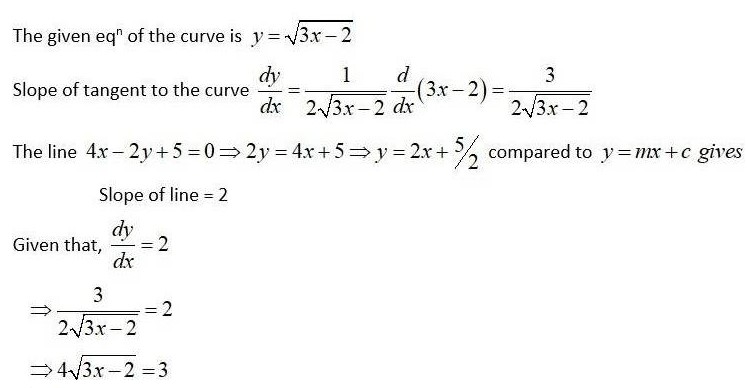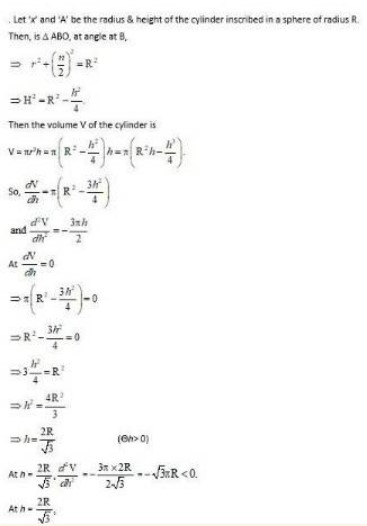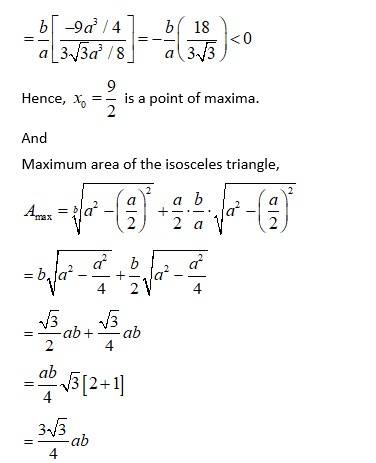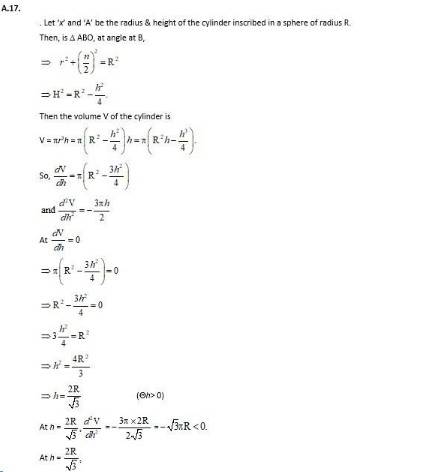
Application of Derivatives Class 12 covers how the derivatives can be used to find the equations of tangent and normal to a curve at a point, to determine the rate of change of quantities, and to find turning points on the graph of a function. The chapter covers the applications of the derivative in various disciplines such as Science, Engineering, Social Sciences, and other fields.
Application of Derivatives Class 12 NCERT Solutions covers the increasing and decreasing functions, the rate of change of quantities, and maxima and minima. The subject matter experts at Shiksha have created the NCERT solution to help students deepen their understanding of concepts. It is ideal for exam preparation. The detailed and step-by-step solutions help students to score high in the CBSE Board exam and competitive exams like JEE Mains.
To get the NCERT Solutions of Class 11 and 12 of all three subjects, including Chemistry, Maths, and Physics, check - NCERT Solutions Class 11 and 12.
- Quick Overview of Applications of Derivatives – Class 12 Maths
- Application of Derivatives NCERT Solution PDF: Free Download
- Class 12 Maths Application of Derivatives: Key Topics, Weightage
- Important Formulas of Application of Derivatives Class 12
- Class 12 Application of Derivatives Exercise 6.1 Solutions
- NCERT Solutions for Class 12 Maths Ch 6 Application of Derivatives- FAQs
- Class 12 Application of Derivatives 6.5 Solutions- (Old NCERT)
- NCERT Class 12 Application of Derivatives Miscellaneous Exercise Solutions
Quick Overview of Applications of Derivatives – Class 12 Maths
Here is a summary of the Applications of Derivatives Class 12 NCERT Solutions:
- The chapter covers the rate of change of quantities and the chain rule.
- It also includes the First Derivative Test, comprising the concepts of local maxima, local minima, and point of inflexion.
- It covers the Second Derivative Test and the working rule of finding absolute maxima and/or absolute minima.
To get access to the NCERT Solutions of all chapters of the Class 12 Maths with free PDF, and important topics, check - Class 12 Maths NCERT Solutions.
Application of Derivatives NCERT Solution PDF: Free Download
Students should download the Application of Derivatives Class 12 PDF from the link given here. It will help them in getting concept clarity and scoring high in the CBSE Board exam and in the JEE Main exam.
Class 12 Math Chapter 6 Application of Derivatives Solution PDF: Free PDF Download
Class 12 Maths Application of Derivatives: Key Topics, Weightage
Application of Derivatives Class 12 is a part of calculus in JEE Main exams, which is a significant area of the Mathematics section. See below the topics covered in this chapter:
| Exercise | Topics Covered |
|---|---|
| 6.1 | Introduction |
| 6.2 | Rate of Change of Quantities |
| 6.3 | Increasing and Decreasing Functions |
| 6.4 | Maxima and Minima |
Application of Derivatives Class 12 Weightage in JEE Mains
| Exam | Number of Questions |
|---|---|
| JEE Main | 2-4 questions |
Related Links
| NCERT Notes for Class 11 & 12 | NCERT Class 12 Notes | Class 12 Maths Notes PDF for CBSE Exams |
Important Formulas of Application of Derivatives Class 12
Application of Derivatives: Important Formulae for CBSE and Competitive Exams
- Rate of Change: , where is the dependent variable and is the independent variable.
- Slope of Tangent:
- Slope of Normal:
- Equation of the tangent:
- Equation of the normal:
- Approximation Formula:
- Condition for Increasing Function:
- Condition for Decreasing Function:
- Local Maxima/Minima (First Derivative Test): Solve and analyze sign changes of around the critical points.
- Conditions for Minima and Maxima:
-
- and for local minima.
- and for local maxima.
-
- Second Derivative Test: Use to confirm the nature of critical points.
Class 12 Application of Derivatives Exercise 6.1 Solutions
Class 12 Application of Derivatives Exercise 6.1 discusses the fundamental usage of Derivative techniques to solve various kinds of problems. Application of Derivatives Exercise 6.1 focuses on the rate of change of quantities, increasing and decreasing functions, tangents and normals, approximations, and finding maxima and minima. The concepts discussed in Class 12 Math Exercise 6.1 Solutions will help students get a good understanding of calculus and even provide tools to solve problems in Class 12 physics and other fields too. Class 12 Ch 6 Exercise 6.1 Solutions includes 18 Questions (10 Long, 6 Short, 2 MCQs). Students can check the complete solutions for Exercise 6.1 below;
Application of Derivatives Exercise 6.1 Solutions
| Q1. Find the rate of change of the area of a circle with respect to its radius r when (πr2) = 2πr. |
| A.1. (a) r = 3cm When r = 3 cm, = 2 × π × 3 cm = 6π. Thus, the area of the circle is changing at the rate of 6π cm . (b) r = 4cm whenr = 4cm, = 2 × π × 4cm = 8π. Thus, the area of the circle is changing at the rate of 8 . |
| Q2. The volume of a cube is increasing at the rate of 8 cm3 /s. How fast is the surface area increasing when the length of an edge is 12 cm? |
| A.2. Let x be the length of edge,v be the value and s be the surface area of the cube then, y = x3. and S = 6x2, where x is a fxn of time. Now, (x3) = 8 (by chain rule) 3x2
Now, (bx2) = = 12x . When x = 12 cm, . |
| Q3. The radius of a circle is increasing uniformly at the rate of 3 cm/s. Find the rate at which the area of the circle is increasing when the radius is 10 cm. |
| A.3. Let ‘r’ cm be the radius of the circle which is afxn of time. Then, = 8 3cm/s as it is increasing. Now, the area A of the circle is A = πr2. So, the rate at which the area of the circle change πr2.
= 2πr 3 = 6πr. When r = 10cm, = 6.π × 10 = 60π |
| Q4. An edge of a variable cube is increasing at the rate of 3 cm/s. How fast is the volume of the cube increasing when the edge is 10 cm long? |
| A.4. Let ‘x’ cm be the length of edge of the cube which is a fxn of time t then, = 3cm/s as it is increasing. Now, volume v of the cube is v = x3 Ø Rate of change of volume of the cube
= 3x2.3 = 9x2 When x = 10cm. = 9 x (10)2= 900 |
Commonly asked questions
27. Prove that is an increasing function of θ .
We have, y =
Differentiating w rt.Ø we get,
When we know that,
So,
And also, (2 + cos)2> 0.
Hence, y is an increasing fxn of in
74.Find the maximum and minimum values, if any, of the following functions
given by.
(i)
(i) We have, f(x) = (2x - 1)2 + 3.
For all
(2x - 1)2 + 3 ≥ 3.
f(x) ≥ 3.
∴The minimum value of f(x) = 3. When 2x - 1 = 0--> x =
Again as as there is vouppa bound to ‘x’ value hence, f(x) has no maximum values.
(ii)
A(ii)
We have, f(x) = 92 + 12x + 2.
(Taking 9 common from each team).
For all
f(x)≥ - 2.
∴The minimum value of f(x) = -2 when
And as so f(x) has
no maximum values.
(iii) f(x) = (x - 1)2 + 10
A(iii)
we have, f(x) = - (x - 1)2 + 10
For all
(x - 1)2 ≤ 0
-(x- 1)2 + 10 ≤ 10.
f(x) ≤ 10.
∴maximum value of f(x) = 10 when x - 1 = 0 x = 1.
And minimum value of f(x) does not exist.
(iv) g(x) = x3 + 1
A(iv)
we have, g(x) = x3 + 1
For the given fxn,
and
Q Maximum and minimum value does not exist.
14. Sand is pouring from a pipe at the rate of 12 cm3 /s. The falling sand forms a cone on the ground in such a way that the height of the cone is always one-sixth of the radius of the base. How fast is the height of the sand cone increasing when the height is 4 cm?
Let r cm and h cm be the radius and the height of the cone. Then,
h = r. H = 6h
So, volume, V of the cone = πr2h
= 12 × h3
Rate of change of volume of the cone wrt the height is
= 12 × π × 3 × h2.
As the sand is pouring from the pipe at rate of 12
we have
Hence, the height is increasing at the rate of cm/s.
63. The slope of the normal to the curve y = 2x2 + 3 sin x at x = 0 is
(A) 3 (B) (C) -3 (D) -
Given,
Slope of tangent,
So, slope of normal
Option (D) is correct.
99. Show that semi-vertical angle of right circular cone of given surface area and maximum volume is .
Kindly go through the solution
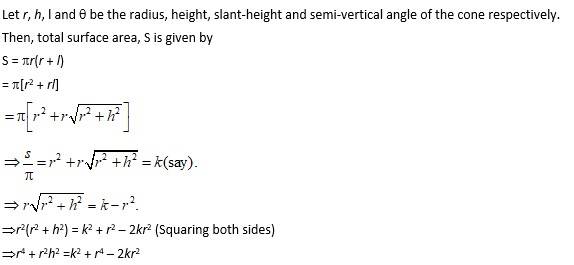
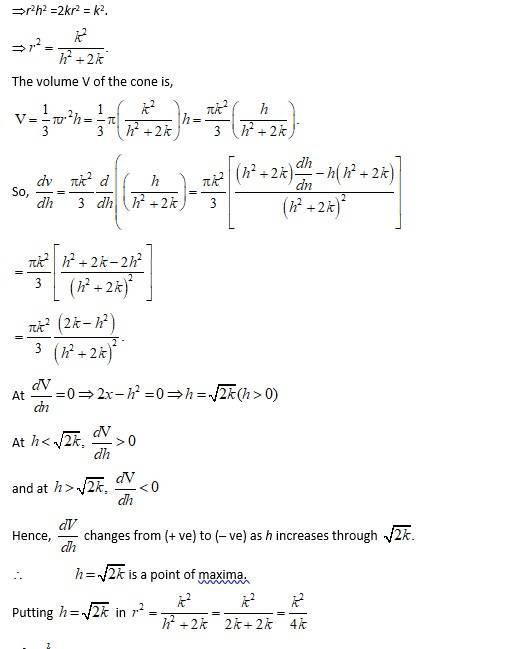
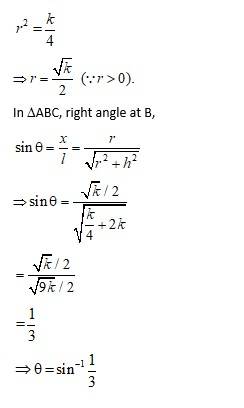
122. The line y = mx + 1 is a tangent to the curve y2 = 4x if the value of m is
(A) 1 (B) 2 (C) 3 (D)
The equation of the tangent to the given curve is
Now, substituting in we get:
Since a tangent touches the curve at one point, the roots of equation (i) must be equal.
Therefore, we have:
Discriminant = 0
Hence, the required value of m is 1.
Therefore, option (A) is correct.
21. Show that the function given by f (x) = sin x is (a)
increasing in (b) decreasing in
(c) neither increasing nor decreasing in
We have, f (x) = sin x.
So, f (x) = cosx.
(a) when, x ∈ i e, x in 1st quadrat.
f (x) = cos.x> 0
f (x) is strictly increasing in .
(b) when, x ∈ in IInd quadrat
f (x) = cosx< 0.
∴f (x) is strictly decreasing (π
(c) When, x ∈ (0, π).
f (x) = cosx is increasing in and decreasing
in and f = cos
∴f (x) is neither increasing not decreasing in (0, π).
32. For what values of a the function f given by f(x) = x2 + ax + 1 is increasing on [1, 2]?
We have, f (x) = x2 + x + 1
So, f (x) = 2x + a
If f (x) is strictly increasing onx
So, 1
The minimum value of f (x) is 2 + a and that of men value is 4 + a.
∴ 2 +a> 0and 4 + a> 0
a> -2 and a> -4.
a> -2.
∴The best value of a is -2.
15. The total cost C (x) in Rupees associated with the production of x units of an item is given by C (x) = 0.007x3 – 0.003x2 + 15x + 4000.
Find the marginal cost when 17 units are produced.
Given, c (x) = 0.007 x3- 0.003x2 + 15x + 400.
Since the marginal cost is the rate of change of total cost wrt the output we have,
Marginal cost, MC, =
= 0.007 * 3x2- 0.003 * 2x + 15.
When x = 17,
Then, MC = 0.007 * 2. (17)2 - 0.003 2 (17) + 15.
= 6.069 - 0.102 + 15.
= 20.967
Hence, the required marginal cost = ' 20, 97.
33. Let I be any interval disjoint from [–1, 1]. Prove that the function f given by
is increasing on I.
We have, f (x) =
So, f (x) =
So, for every x∈ I, where I is disjoint from [-1,1]
f (x) =
and f (x) = = ( + ve) > 0 when x< -1.
∴f (x) is strictly increasing on I .
44. Find points at which the tangent to the curve y = x3 – 3x2 – 9x + 7 is parallel to the x-axis.
The given eqn of the curve is
slope of tangent to the given curve,
when the tangent is parallel to x-axis
x = 3 or x = -1
When x = 3,
And when x = -1
Hence, the required points are
22. Find the intervals in which the function f given by f(x) = 2x2 – 3x is
(a) Increasing (b) Decreasing
We have, f (x) = 2x2 3x
So, f (x) =
Atf (x) = 0.
4x - 3 = 0
i e, divides the real line into two
disjoint interval
(a) Now,
f (x) = 4x - 3 > 0
So, f (x) is strictly increasing in
(b) Now, f (x) = 4x - 3 < 0
So, f (x) is strictly decreasing in
23. Find the intervals in which the function f given by f(x) = 2x3 – 3x2 – 36x + 7 is
(a) Increasing (b) Decreasing
We have, f (x) = 2x3- 3x2- 36x + 7.
So, f (x) =
= 6 (x2-x- 6).
= 6 (x2- 3x + 2x- 6)
= 6 [x (x- 3) + 2 (x- 3)]
= 6 (x- 3) (x + 2).
At, f (x) = 0
6 (x- 3) (x + 2) = 0.
So, when x- 3 = 0 or x + 2 = 0.
x = 3 or x = -2.
Hence we an divide the real line into three disjoint internal
I
At x ∈
f (x) = ( + ve) ( -ve) ( -ve) = ( + ve) > 0.
So, f (x) is strictly increasing in
At, x∈ ( -2,3),
f (x) = ( + ve) ( + ve) ( -ve) = ( -ve) < 0.
So, f (x) is strictly decreasing in ( -2,3).
At, x ∈
f (x) = ( + ve) ( + ve) ( + ve) = ( + )ve> 0.
So, f (x) is strictly increasing in
∴ (a) f (x) is strictly increasing in
(b) f (x) is strictly decreasing in ( -2,3)
19. Show that the function given by f (x) = 3x + 17 is increasing on R.
We have, .
f (x) = 3x + 17.
So, f (x) = 3 > 0
∴f (x) is strictly increasing on R.
20. Show that the function given by f (x) = e2x is increasing on R.
We have, f (x) = e2x
So, f (x) = = = 2e2x> 0
∴f (x) is strictly increasing on R.
25. Show that 2 log(1 ) 2 x y x x = +− + , x > – 1, is an increasing function of x throughout its domain.
We have, y = log
Differentiating the above wrt.x.we get,
The given domain of the given function isx> -1.
(x + 1) > 0.
Also,
(2 + x)2> 0.
Hence,
∴ y is an increasing function of x throughout its domain.
24. Find the intervals in which the following functions are strictly increasing or decreasing:
(a) x2 + 2x – 5 (b) 10 – 6x – 2x2 (c) –2x3 – 9x2 – 12x + 1 (d) 6 – 9x – x2
(e) (x + 1)3 (x – 3)3
(a) f (x) = x2 + 2x - 5.
f(x) = 2x + 2 = 2 (x + 1).
At, f(x) = 0
2 (x + 1) = 0
x = -1.
At, x
f(x) = (- ) ve< 0.
So, f (x)is strictly decreasing or
At x ∈
f(x) = ( + ve) > 1
f(x) is strictly increasing on
(b) f(x) = 10 - 6x- 2x2
So, f(x) = - 6 - 4x = - 2 (3 + 2x).
Atf(x) = 0
2 (3 + 2x) = 0.
x =
At x
∴f(x) is strictly increasing on
At x
f(x) = ( -ve) ( + ve) = ( - ) ve< 0.
∴f (x) is strictly decreasing on
(c) f (x) = 2x3- 9x2- 12x.
So, f (x) =- 6x2- 18x- 12 = - 6 (x2 + 3x + 2).
= -6 [x2 + x + 2x + 2]
= -6 [x (x + 1) + 2 (x + 1)]
= -6 (x + 1) (x + 2)
At, f (x) = 0.
6 (x + 1) (x + 2) = 0
x = -1 and x = -2.
At, x , f(x) = ( -ve) ( -ve) ( -ve) = ( -ve) < 0
So, f(x) is strictly decreasing.
At, x( -2, -1), f(x) = ( -ve) ( -ve) ( -ve) = ( -ve) < 0.
So, f(x) is strictly decreasing
(d) f(x) = 6 - 9x-x2
So, f(x) = - 9 - 2x
At, f(x) = 0
9 - 2x = 0
x =
At, x ∈
f(x) > 0
So, f(x) is strictly increasing.
At x ∈
f(x) < 0.
So, f(x) is strictly decreasing.
(e) f(x) = (x + 1)3 (x- 3)3.
So, f(x) = (x + 1)3
= (x + 1)3. 3 (x- 3)2 + (x- 3)3. 3 (x + 1)2
= 3 (x + 1)2 (x- 3)2 (x + 1 + x- 3).
= 3 (x + 1)2 (x- 3)2 (2x- 2).
= 6 (x + 1)2 (x- 3)2 (x- 1).
For strictly increasing,
f(x) > 0.
As 6 > 0,(x + 1)2> 0 and (x- 3)2> 0. We need
(x 1) > 0.
x> 1.
∴f (x) is strictly increasing on
And strictly decreasing on
42. Find the slope of the normal to the curve
The Equation of the given curve are
So,
and
So, which is the slope of the tanget to the curve.
Now, required slope of normal to the curve =
92. Show that of all the rectangles inscribed in a given fixed circle, the square has the maximum area.
Let A.B.C.D.be the square increased in a given fixed circle with radius x
Let ‘x’ and ‘y’ be the length and breadth of the rectangle
∴x, y> 0
In ABC, right angle at B,
x2 + y2 = (2x)2
x2 + y2 = 4x2
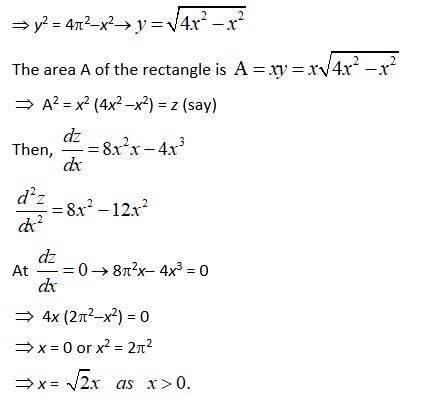
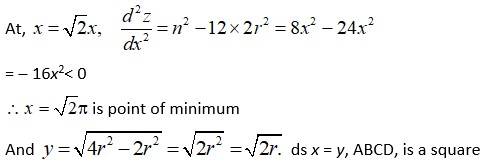
30. Which of the following functions are decreasing on ?
(A) cos x (B) cos 2x (C) cos 3x (D) tan x
(A) We have,
f(x) = cosx
So, f(x) = -sin x
When x we know that sin x> 0.
-sinx< 0. f(x) < 0
∴f(x) is strictly decreasing on
(B) We have, f(x) = cos 2x
So, f(x) = -2sin 2x
When we know that sin x> 0.
i e, 0
=> 0<2x<π
So, sin 2x> 0 (sinØ is ( +ve) in 1st and 2ndquadrant).
-2sin 2x< 0.
f (x) < 0.
∴f (x) is strictly decreasing on
(c) We have, f(x) = cos 3x
f(x) = -3 sin 3x.
As
We can divide the interval into two
Case I At, 0 < 3x
sin 3x> 0.
-3 sin 3x< 0
f(x) < 0.
∴f(x) is strictly decreasing on
case II. At
sin 3x< 0.
-3 sin 3x> 0.
f(x) > 0.
∴f(x) is strictly increasing on
Hence, f(x) is with a increasing or decreasing on
(d) We have, f(x) = tan x.
So, f(x) = sec2x.
f(x) = sec2x> 0
∴f(x) is strictly increasing on
Hence, the fxncosx and cos 2x are strictly decreasing on
97. Show that the right circular cone of least curved surface and given volume has an altitude equal to √2 time the radius of the base.
Let r and h be the radius and height of the cone.
The volume V of the cone is.
And curve surface area S is
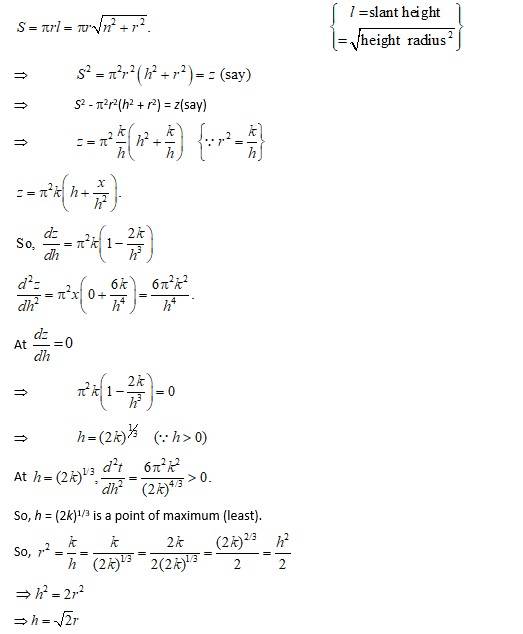
1. Find the rate of change of the area of a circle with respect to its radius r when
(πr2) = 2πr.
(a) r = 3cm
When r = 3 cm,
= 2 × π × 3 cm = 6π.
Thus, the area of the circle is changing at the rate of 6π cm .
(b) r = 4cm
whenr = 4cm,
= 2 × π × 4cm = 8π.
Thus, the area of the circle is changing at the rate of 8 .
31. On which of the following intervals is the function f given by f(x) = x100 + sin x –1 decreasing ?
(A) (0,1) (B) (C) (D) None of these
We have, f (x) = x 100 + sin x - 1.
So, f (x) = 100x99 + cosx.
(A) When x (0,1). We get.
x>0
x99> 0
100 x99> 0.
Now, 0 radian = 0 degree
and 1 radian =
So, cosx> 0 for x∈ (0,1) radian = (0,57)
∴f (x) > 0 for x∈ (0,1).
(B) When x ∈ we get,
So, x> 1
x99> 1
100x99> 100.
And cosx is negative between -1 and 0.
So, f (x) = 100x99 + cosx> 100 - 1 = 99 > 0.
∴f(x) is strictly increasing on
(c) When x ∈ we get,
x> 0
x99> 0
100x99> 0
and cosx> 0. (firstquadrant).
I e, f(x) > 0.
∴f(x) is strictly increasing on
Hence, option (D) is correct.
Q38. Find the slope of the tangent to the curve y = 3x4 – 4x at x = 4.
The given eqn of the curve is
Slope of the tangent at x = 4 is given by
= 764
62. Find the equation of the tangent to the curve y = √3x - 2 which is parallel to the line 4x - 2y + 5 = 0.
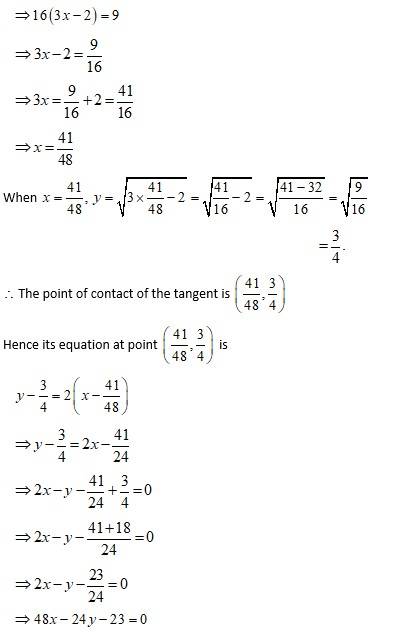
18. The total revenue in Rupees received from the sale of x units of a product is given by R(x) = 3x2 + 36x + 5. The marginal revenue, when x = 15 is
(A) 116 (B) 96 (C) 90 (D) 126
Given, R (x) = 3x2 + 36x + 5.
Marginal revenue,
= 3 * 2x + 36
= 6x + 36
When x = 15.
= 90 + 36 = 126
Option (D) is correct.
29. Prove that the function f given by f(x) = x2 – x + 1 is neither strictly increasing nor decreasing on (– 1, 1).
We have, f (x) = x2-x + 1.
So, f (x) =
Atf (x) = 0.
2x - 1 = 0
I e, x = divides the real line into two disjoint interval the interval ( -1, 1) into
Two disjoint interval
And f (x) is strictly increasing in and strictly decreasing in
Hence, f (x) is with a increasing or decreasing on ( -1,1).
11. A particle moves along the curve 6y = x3 +2. Find the points on the curve at which the y-coordinate is changing 8 times as fast as the x-coordinate
Given eqn of the curve is 6y = x3 + 2.______ (1)
Wheny coordinate change s 8 times as fast as x-coordinate
= 8 _____ (2)
Now, differentiating eqn (1) wrt.x we get,
6 × 8 = 3x2 (using eqn (2)
x = 4.
When x = 4, we have, 6y = 43+ 2 = 64 + 2 + 66
y =11.
And when x = -4, we have, 6y = ( -4)3 + 2 = -64 + 2 = -62
The tequired point s are (4, 11) and
13. A balloon, which always remains spherical, has a variable diameter 3 (2 1) 2 x + . Find the rate of change of its volume with respect to x.
Given, diameter of the spherical balloon = (2x + 1)
So, radius of the spherical r =
Then, volume of the spherical V =
Q Rate of change of volume wrt.tox,
26. Find the values of x for which y = [x(x – 2)]2 is an increasing function.
We have, y = [x (x- 2)]2.
Differentiating the above w rt. x we get,
= 2 [x (x- 2)] (x + x- 2)
= 2x (x - 2) (2x - 2)
= 4x (x - 2) (x - 1).
Now,
4x (x - 2) (x - 1) = 0.
i e, x = 0, x = 2, x = 1 divides the real line into
four disjoint interval. [0,1],[1,2] and
when x
∴f (x) is decreasing in
When
∴f (x) is increasing in [0,1].
When x
∴f (x) is decreasing.
When
∴f (x) is in creasing
Hence, f (x) is increasing for x
28. Prove that the logarithmic function is increasing on (0, ∞).
We have, f (x) = log x.
So, f (x) =
i e, f (x) > 0. When
Hence, the logarithmic fx is strictly increasing on
34. Prove that the function f given by f(x) = log sin x is increasing on and decreasing on .
We have, f (x) = log sin x
So, f (x) =
When
f (x) = cot x> 0 (Ist quadrat )
So, f (x) is strictly increasing on
When x ∈
f (x) = cot x< 0. (IIndquadrant ).
So, f (x) is strictly decreasing on
35. Prove that the function f given by f (x) = log |cos x| is decreasing on and increasing on
We have, f (x) = log
f (x) =
whenx we get.
tanx> 0 (Ist quadrant).
tanx< 0
f (x) < 0.
∴f (x) is decreasing on
When x ∈ we get,
tanx|< |0 (ivth quadrant).
-tanx|>| 0
f (x) > 0
∴f (x) is increasing on
37. The interval in which y = x2 e–x is increasing is (A) (– ∞, ∞) (B) (– 2, 0) (C) (2, ∞) (D) (0, 2)
We have, f (x) = x2 e–x
So, f (x) =
= -x2 e-x + e-x 2x.
= x e-x ( x + 2).
If f (x) = 0.
x = 0, x = 2.
Hence, we get there disjoint interval
When, x we have, f (x) = ( -ve) ( + ve) = ( -ve) < 0.
So, f is strictly decreasing.
When x ∈ (0,2), f (x) = ( + ve) ( + ve) = ( + ve) > 0.
So, f is strictly increasing.
And when x ∈ f (x) = ( +ve) ( -ve) = ( -ve) < 0.
So, f is strictly decreasing.
Hence, option (D) is correct.
66. Find the approximate value of f(2.01), where f (x) = 4x2 + 5x + 2.
Given, y = f (x) = 4x2 + 5x + 2.
So, f (x) = 8x + 5. = 8x + 5 dy = (8x + 5) dx.
Let x = 2 and Δx = 0.01.Then,
f (x + Δx) = f (2 + 0.01) = f (2.01).
Δy = f. (x + Δx) f (Δx).
f (x +Δx) = f (x) +Δy.
= f (x) + dy = f (x) + (8x + 5) dx.
= f (2.01) = f (2) + (8 x 2 + 5). Δx {∴dx = Δx}
= 4 (2)2 + 5 (2) + 2 + 21 (0.01)
= 16 + 10 + 2 + 0.21 = 28.21.
68. Find the approximate change in the volume V of a cube of side x metres caused by increasing the side by 1%.
We know that, the volume v of side ‘a’ mete of cube is v = x3.
So,
Given that, increase in side = 1% of x.
82. What is the maximum value of the function sin x + cos x?
We have, f (x) = sin x + cos x.
f (x) = cos x - sin x.
At f (x) = 0
cosx - sin x = 0
sinx = cos x
At ,
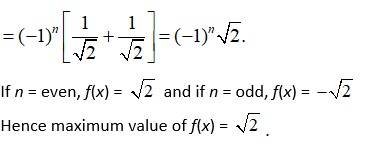
85. Find the maximum and minimum values of x + sin 2x on [0, 2π].
We have, f(x) = x + sin 2x ,x ∈ [0, 2π].
f(x) = 1 + 2cos 2x
At f(x) = 0
1 + 2 cos2x = 0
Hence,
Missing
At
= 1.05 + 0.87
= 1.92
At
= 1.23
At
=5.07.
At
= 5.25 - 0.87 = 4.38
At and points,
f(0) = 0 + sin2 × 0 = 0
f(2π) = 2π + sin 2 × 2π = 6.2 + 0 = 6.28
∴Maximum value of f(x) = 6.28 at x = 2π and
minimum value of f(x) = 0 at x= 0
120. Show that height of the cylinder of greatest volume which can be inscribed in a right circular cone of height h and semi vertical angle α is one-third that of the cone and the greatest volume of cylinder is .
Kindly go through the solution
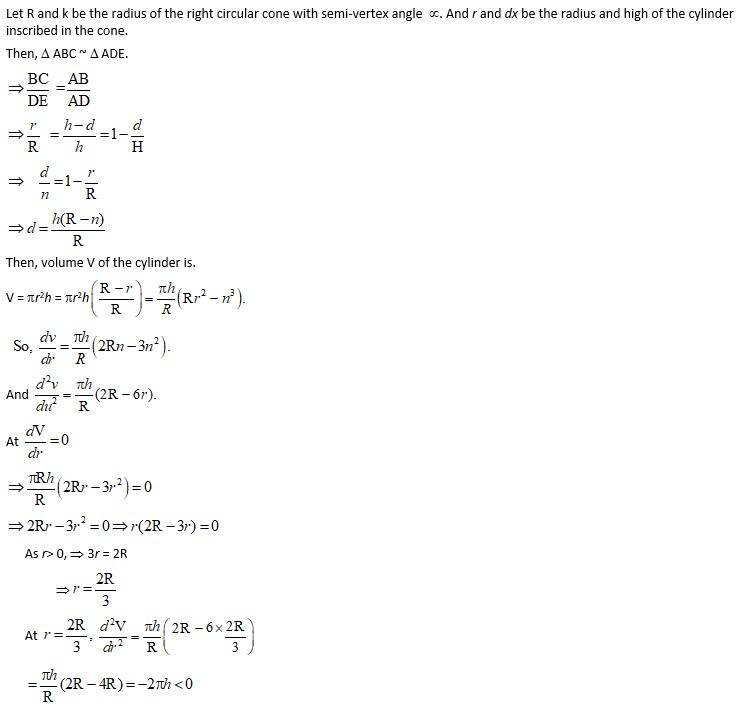

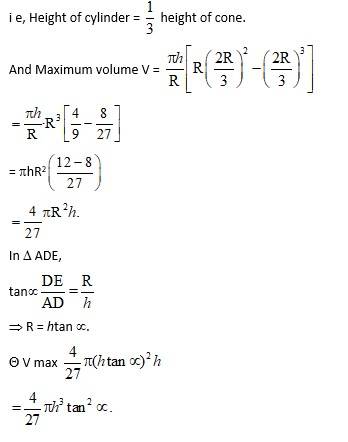
123. The normal at the point (1,1) on the curve 2y + x2 = 3 is (A) x + y = 0 (B) x – y = 0 (C) x + y +1 = 0 (D) x – y = 1
The equation of the given curve is .
Differentiate with respect to x, we have:
The slope of the normal to the given curve at point (1,1) is
Hence, the equation of the normal to the given curve at (1,1) is given as:
Therefore, option (B) is correct.
2. The volume of a cube is increasing at the rate of 8 cm3 /s. How fast is the surface area increasing when the length of an edge is 12 cm?
Let x be the length of edge,v be the value and s be the surface area of the cube then,
y = x3.
and S = 6x2, where x is a fxn of time.
Now,
(x3) = 8
(by chain rule)
3x2
Now, (bx2) = = 12x .
When x = 12 cm,
.
3. The radius of a circle is increasing uniformly at the rate of 3 cm/s. Find the rate at which the area of the circle is increasing when the radius is 10 cm.
Let ‘r’ cm be the radius of the circle which is afxn of time.
Then, = 8 3cm/s as it is increasing.
Now, the area A of the circle is A = πr2.
So, the rate at which the area of the circle change πr2.
= 2πr 3
= 6πr.
When r = 10cm,
= 6.π × 10 = 60π
4. An edge of a variable cube is increasing at the rate of 3 cm/s. How fast is the volume of the cube increasing when the edge is 10 cm long?
Let 'x' cm be the length of edge of the cube which is a fxn of time t then,
= 3cm/s as it is increasing.
Now, volume v of the cube is v = x3
Ø Rate of change of volume of the cube
= 3x2.3
= 9x2
When x = 10cm.
= 9 x (10)2= 900
5. A stone is dropped into a quiet lake and waves move in circles at the speed of 5 cm/s. At the instant when the radius of the circular wave is 8 cm, how fast is the enclosed area increasing?
The area A of the circle with radius π is A = πr2
Then, rate of change in area =
= 2πr
Q The wave moves at a rate 5cm/s we have,
= 5cm/s
So, =r. 5 = 10πr.
When r = 8 cm.
= 10.π.8 cm = 80 × cm
6. The radius of a circle is increasing at the rate of 0.7 cm/s. What is the rate of increase of its circumference?
The circumference C of the circle with radius r is C = 2πr.
Then, rate of change in circumference is =
Q Radius of circle increases at rate 0.7 cm/s we get,
cm/s
So, = 2.× 0.7 cm/s = 1.4 × cm/s.
7. The length x of a rectangle is decreasing at the rate of 5 cm/minute and the width y is increasing at the rate of 4 cm/minute. When x = 8cm and y = 6cm, find the rates of change of (a) the perimeter, and (b) the area of the rectangle.
Since the length x is decreasing and the widthy is increasing with respect to time we have
= 5cm/min and = A cm/min
(a) The perimeter P of a rectangle will be, P = 2 (x + y)
Q Rate of change of perimeter,
= 2 ( -5 + 4)
= -2 cm/min
(b) The area A of the rectangle is A = x. y.
Rate of change of area is
= 4x - 5y
So, |x = 8ay = 6cm = 4 (8) - 5 (6) = 32 - 30 = 2 cm2/min spherical balloon
8. A balloon, which always remains spherical on inflation, is being inflated by pumping in 900 cubic centimetres of gas per second. Find the rate at which the radius of the balloon increases when the radius is 15 cm
Let ‘r’ cm be the radius of volume V. measured Then,
Now, rate at which balloon is being inflated = 900
= 900
× 3 × r2 = 900.
When r = 15cm,
= cm/s.
Q Radius of balloon increases by per second.
9. A balloon, which always remains spherical has a variable radius. Find the rate at which its volume is increasing with the radius when the later is 10 cm
The volume v of a spherical balloon with radius r is V.
with respect its radius.
Then, the rate of change of volume
= 4 r2
Whenx = 10 cm,
= 4 10)2 = 400 cm3/cm
10. A ladder 5 m long is leaning against a wall. The bottom of the ladder is pulled along the ground, away from the wall, at the rate of 2cm/s. How fast is its height on the wall decreasing when the foot of the ladder is 4 m away from the wall ?
Since, the bottom of ground is increasing with time t,
= 2cm/s
From fig, Δ ABC, by Pythagorastheorem
AB2 + BC2 = AC2
x2 + y2 = 52
x2 + y2 = 25 ____ (1)
Differentiating eqn (1) w. r. t. time t we get,
m/s
When x = 4m, the rate at which its height on the wall decreases is
room
12. The radius of an air bubble is increasing at the rate of 1 2 cm/s. At what rate is the volume of the bubble increasing when the radius is 1 cm?
Let x be the radius of the bubble with volume .V. then,
cm/s
andV =
Rate of change of volume =
= 4πr2 ×
= 2πr2.
= 2x (1)2 2π.
16. The total revenue in Rupees received from the sale of x units of a product is given by R (x) = 13x2 + 26x + 15. Find the marginal revenue when x = 7.
Given, R (x) = 13x2 + 26x + 15.
Marginal revenue is the rate of change of total revenue with respect to the number of units sold Marginal revenue (MR) =
= 13 * 2x + 26
= 26x + 26
When x = 7,
MR = 26 * 7 + 26 = 182 + 26 = 208.
Hence, the required marginal reverse = ' 208.
Choose the correct answer for questions 17 and 18.
17. The rate of change of the area of a circle with respect to its radius r at r = 6 cm is
(A) 10π (B) 12π (C) 8π (D) 11π
The area A of the isle with radius r is given by with respect to radius r A = πr2.
Then, rate of change of area of the circle
= 2πr.
When r = 6 cm
Q option (B) is correct.
39. Find the slope of the tangent to the curve
The given eqn of the curve is
Slope of tangent at x = 10 is given by,
40. Find the slope of the tangent to curve y = x3 – x + 1 at the point whose x- coordinate is 2.
Slope of tangent to the given curve is
So,
41. Find the slope of the tangent to the curve y = x3 –3x + 2 at the point whose x-coordinate is 3.
Slope of tangent to the given curve is
so,
43. Find the slope of the normal to the curve
The given eqn of the curves are
so,
Slope of tangent to curve at is
Hence, slope of normal to curve
45. Find a point on the curve y = (x – 2)2 at which the tangent is parallel to the chord joining the points (2, 0) and (4, 4)
Let the point joining the chord be
Then slope of the chord
= 2
The given eqn of the curve
slope of the tangent to the curve
Given that, the tangent is parallel to the chord PQ.
slope of tangent = slope of PQ.
and
The required point on curve is
46. Find the point on the curve y = x3 – 11x + 5 at which the tangent is y = x – 11.
The given eqn of the curve is
slope of tangent to the curve
Then eqn of tangent is which gives us slope
So,
When x = 2,
And when x = 2,
The point when put into we get
which is true.
and the point when put into gives,
which is not true.
Hence, the required point is
47. Find the equation of all lines having slope – 1 that are tangents to the curve
The given eqn of curve is
Slope of tangent to the given curve is
Given that, slope of tangent = 1.
ie, X=1+1 or
or
When
and when
Hence, the point of contact of the tangents are
The reqd. eqn of line are
and
and
and
48. Find the equation of all lines having slope 2 which are tangents to the curve
The given eqn of curve is
Slope of tangent to the curve is
Given,
which is not possible
we conclude that there is no possible tangent to the given curve with slope = 2.
49. Find the equations of all lines having slope 0 which are tangent to the curve
The given eqn of the curve is
Slope of tangent to the curve is
Given,
When
The point of contact of the tangent to the curve is
The eqn of the line is
50. Find points on the curve at which the tangents are
(i) Parallel to x-axis (ii) Parallel to y-axis.
Diffrentiating wrt. X we get,
(i) When the tangent is || to x-axis, the slope of tangent is 0
ie,
putting this in the eqn of curve. We get,
The point at which the tangents are parallel to x-axis are
(ii) When the tangent is parallel to y-axis, the slope of the normal is 0.
ie,
, putting this in the eqn of curve we get,
The point at which the tangents are parallel to y-axis are
51. Find the equations of the tangent and normal to the given curves at the indicated points:
(i) we have,
slope of tangent,
slope of normal
Hence eqn of tangent at (0, 5) is
And eqn of normal at (0, 5) is
(ii) We have,
Slope of tangent,
= 30 28
= 2
Slope of normal
Hence eqn of tangent at (1, 3) is
And eqn of normal at (1,3) is
(iii) We have,
Slope of tangent,
And slope of normal
Hence, eqn of tangent at (1, 1) is
And eqn of normal at (1,1) is
(iv) We have,
Slope of tangent
So, eqn of the tangent at (0,0) is
ie, x- axis
Hence, the eqn of normal is x = 0 ie, y-axis
(v) We have,
So, slope of tangent
And slope of normal
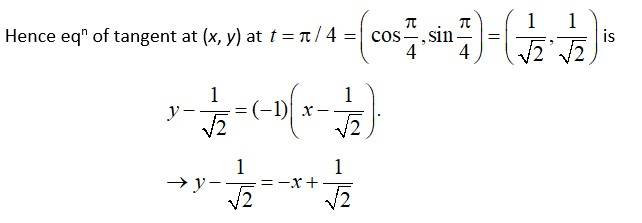
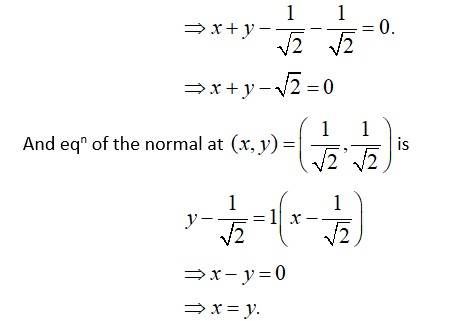
52. Find the equation of the tangent line to the curve y = x2 – 2x +7 which is
(a) Parallel to the line 2x – y + 9 = 0 (b) Perpendicular to the line 5y – 15x = 13
The eqnof the given curve is
Slope of tangent,
(a) The line compared to gives,
Slope of line = 2.
If the tangent of the curve is parallel to the line
When
Hence, the point of contact of the tangent is (2, 7)
The eqn of tangent is
(b) The line
compared to gives
slope of line = 3
As the tangent to the curve is ⊥ to the line.
When we get
Hence, the point of contact of the tangent is
And eqn of the tangent is
53. Show that the tangents to the curve y = 7x3 + 11 at the points where x = 2 and x = – 2 are parallel.
The given eqn of the curve is .
Slope of tangent
and
The tangent to the given curve at x = 2 and x = -2 are parallel.
54. Find the points on the curve y = x3 at which the slope of the tangent is equal to the y-coordinate of the point.
The given eqn of the curve is .
Slope of tangent,
As, slope of tangent = y – coordinate of the point.
When
and when
The required points are
55. For the curve y = 4x3 – 2x5 , find all the points at which the tangent passes through the origin.
The given eqn of the curve is
Slope of tangent, ________(1)
Let P(x, y) be the required point at the tangent passing through the origin (0,0)
Then, _________(2)
So, from (1) and (2) we get,
Putting this value of y in the eqn of curve we get,
or
or
When,
The required points are (0,0), (1,2) and (1,2)
56. Find the points on the curve x2 + y2 – 2x – 3 = 0 at which the tangents are parallel to the x-axis.
The given eqnof the curve is ________ (1)
Differentiating the given curve wrt.x we get,
slope of tangent
Given, tangent is | to x-axis
ie,
Putting x = 1 in eqn (1) we get,
Hence, the required points are (1,2) and (1, 2).
57. Find the equation of the normal at the point (am2 ,am3 ) for the curve ay2 = x3
The given eqn of curve is _____(1)
Differentiating eqn (1) wrt.x we get,
, slope of tangent
corresponding slope of normal
Hence, eqn of normal at is
58. Find the equation of the normals to the curve y = x3 + 2x + 6 which are parallel to the line x + 14y + 4 = 0.
The given eqn of the curve is _____(1)
slope of tangent to the curve,
so, slope of normal to the curve
Now, the line compared to gives
slope of line =
As the normal is parallel to the line
When
and when
The point of contact of the normal are (2, 18) and (-2, -6)
Hence the eqn of normal are
and
59. Find the equations of the tangent and normal to the parabola y2 = 4ax at the point (at2 , 2at).
The given of the parabola is
slope of tangent is given by
so, slope of normal
so, slope of normal
Hence eqn of tangent at point is
And eqn of normal at point is
60. Prove that the curves x = y2 and xy = k cut at right angles* if 8k2 = 1.
The given eqn of the curves are
________(1)
and ___________(2)
Differentiating eqn (1) and (2) wrt ‘x’ we get,
_________(3)
and
_________(4)
Since the two curves cut each other at right angles we get,
________(5)
The point of intersection can be solve from eqn (1) and (2),
Hence, using eqn (5) we get,
Hence proved
61. Find the equations of the tangent and normal to the hyperbola
at the point
The given eqn of the hyperbola is ______(1)
Differentiating eqn (1) wrt ‘x’ we get,
is the reqd slope of tangent to the curve
So, eqn of tangent at point is
As lies on the parabola given by eqn (1) we write,
Hence,
64. The line y = x + 1 is a tangent to the curve y2 = 4x at the point (A) (1, 2) (B) (2, 1) (C) (1, – 2) (D) (– 1, 2)
The given eqn of curve is .
Then, differentiating wrt x we get,
which is the slope of the tangent to the curve.
The line compared to gives slope of line = 1.
Since, tangent is the line we have,
Putting y = 2 in we get,
Hence, the required point is
Option (A) is correct.
65. Using differentials, find the approximate value of each of the following up to 3 places of decimal.
(i) Let y= ?x : Let x = 25 and x = 0. 3.
Then, ?y = ?x+?x
= 5 + dy
=
= 5 + 0.03
(ii) ?49.5
A.(ii)
Let y = ?x Let x = 49 and x = 0.5.
Then,
= 7 + 0.0357.
(iii) ?0.6
A.(iii)
Let y = ?x Let x = 0.64 and ?x = 0.04.
Then,
= 0.8 - 0.025.
= 0.775.
(iv)
A.(iv)
Let Let x = 0.008 and ?x = 0.00 1.
Then, ?y =
= 0.2 + 0.0083.
= 0.208.
(v)
A.(v)
Let Let x = 1 and ?x = -0.001
Then,
= 0.999.
(vi)
A.(vi)
Let Then, x = 16 and ?x = 1.
Then,
(vii)
A.(vii)
Let Let x = 27 and ?x = 1.
Then,
(viii)
A.(viii)
Let Let x = 256 and ?x = 1.
Then,
(ix)
A.(ix)
Let let x = 81 and ?x = 1.
Then,
(x)
A.(x)
Let y = = ?x Let x = 400 and ?x = 1.
Then,
(xi)
A.(xi)
Let Let x = 0.0036 and ?x = 0.0001
Then,
= 0.06 + 0.0008.
= 0.0608.
(xii)
A.(xii)
Let Let x = 27 and ?x = 0.43.
Then,
67. Find the approximate value of f (5.001), where f(x) = x3 – 7x2 + 15.
Given, y = f (x) = x3- 7x2 + 15.
So,
dy = (3x2- 14x) dx.
Δy = (3x2- 14x) Δx.
Let, x = 5 and Δx = 0.001. Then,
Δy = f (x + Δx) f (x).
f (x + Δx) = f (x) + Δy = f (x) + (3x2- 4x) Δx.
f (5 + 0.001) = 53- 7 (5)2 + 15 + [3 (5)2 - 14 (5)]. (0.001).
f (5.001) = 125 - 175 + 15 + (75 - 70) (0.001)
= -35 + 0.005 = - 34.995.
69. Find the approximate change in the surface area of a cube of side x metres caused by decreasing the side by 1%
We know that, the surface area 5 of a ‘x’ when length cube, is S = 6x2.
So,
Given decrease in side,
70. If the radius of a sphere is measured as 7 m with an error of 0.02 m, then find the approximate error in calculating its volume.
Let x be the radius of the sphere & Δπ be the error in measuring the radius.
Then, π = 7m and Δr = 0.02m.
Now, volume v of sphere is
So,
dv = 4π (7)2 (.0.02) = 3.92 πm3
∴The appropriate error is calculating the volume is 3.92πm3.
71. If the radius of a sphere is measured as 9 m with an error of 0.03 m, then find the approximate error in calculating its surface area.
Let be the radius of the sphere &r be the error in measuring the radius.
Then, π = 9m and Δr = 0.03m.
Now, surface area S of the sphere is
S = 4πr2
So,
∴e, this = Δr = 8πr.Δr = 8π × 9 × 0.03
= 2.16πm3.
Appropriate error in calculating the surface area is 2.16πm3.
72. If f(x) = 3x2 + 15x + 5, then the approximate value of f (3.02) is (A) 47.66 (B) 57.66 (C) 67.66 (D) 77.66
We have, y = f (x) = 3x2 + 15x + 5.
dy = (6x + 15) dx
Δy = (6x + 15) Δx.
Let, x = 3 and Δx = 0.02 then,
Δy = f (x + Δx) - f (x)
f (x + Δx) = f (x) + Δy = f (x) + (6x + 5) Δx.
f (3 + 0.02) = 3 (3)2 + 15 (3) + 5 + (6 × 3 + 15) (0.02).
f (3.02) = 27 + 45 + 5 + (18 + 15) (0.02).
= 77 + 0.66
= 77.66
∴ Option (D) is correct.
73. The approximate change in the volume of a cube of side x metres caused by increasing the side by 3% is (A) 0.06 x3 m3 (B) 0.6 x3 m3 (C) 0.09 x3 m3 (D) 0.9 x3 m3
The volume v of a cube with side ‘x’ metre is v = x3
So,
∴increase in side, Δx = 3% of =
∴dv = 3x2π
Hence, option (C) is correct.
75. Find the maximum and minimum values, if any, of the following functions given by
(i) f(x) = |x + 2| - 1
(i) we have, f(x) = |x + 2| - 1
We know that, for all
f(x)- 1.
∴ Minimum value of f(x) = -1 when x + 2 = 0 x = - 2.
And maximum value of f(x) does not exist.
(ii)
A(ii)
We have,
For all
g(x) 3.
∴ Maximum value of g(x) = 3 when
And minimum value does not exist.
(iii) h(x) = sin (2x) + 5.
A(iii)
we have, h(x) = sin (2x) + 5.
For all {range of sine function is [-1, 1]}
-1 + 5 sin 2x + 5 1 + 5.
4 h(x) 6.
∴ Maximum value of h(x) = 6.
Minimum value of h(x) = 4.
(iv)
A(iv)
we have,
As for all
-1 + 3 sin 4x + 3 1 + 3
2 f(x) 4.
∴ Maximum value of f(x) = 4.
Minimum value of f(x) = 2.
(v) h(x) = x + 1.,x∈ ( -1, 1).
A(v)
we have, h(x) = x + 1.,x∈ ( -1, 1).
Given, -1
- 1 + 1 <x + 1 < 1 + 1
0 <h (x) < 2.
∴ Maximum value and minimum value of h(x) does not exist.
76. Find the local maxima and local minima, if any, of the following functions.
Find also the local maximum and the local minimum values, as the case may be:
(i) f(x) = x2.
(i) we have, f(x) = x2.
f(x) = 2x.
andf(x) = 2.
AR extreme point, f(x) = 0
2x = 0
x = 0.
When x = 0, f(0) = 2 > 0.
∴x = 0 is a point of local minima and value of local minimum is given by f(0) = 02 = 0.
(ii) g(x) = x3 3x
A(ii)
we have, g(x) = x3- 3x
g'(x) = 3x2- 3
g''(x) = 6x.
At extreme point,
g'(x) = 0
3x2- 3 = 0.
3(x2- 1) = 0 ⇒ 3(x - 1)(x + 1) = 0.
x = 1 or x = -1.
At x = 1, g"(1) = 6.1 = 6 > 0.
So, x = 1 is a point of local minima and value of local minimum is given by g(1) = 13- 3.1 = 1 - 3 = - 2.
And at x = -1, g"( -1) = 6 ( -1) = 6 < 0.
So, x = -1 is a point of local minima and value of local minimum is given by
g(- 1) = (- 1)3- 3(- 1) = 1 + 3 = 2.
(iii)
A(iii)
we have, h(x) = sin x + cos x.
h'(x) = cos x - sin x
h'(x) = -sin x - cos x.
At extreme points,
h'(x) = 0
cosx - sin x = 0
cosx = sin x
1 = tan x

(iv)
A(iv)
we have, f(x) = sin x cos x.
f(x) = cos x + sin x
f(x) = sin x + cos x.
At extreme points,
f(x) = 0
cosx + sin x = 0.
IInd quadrate or IIIth quadrate
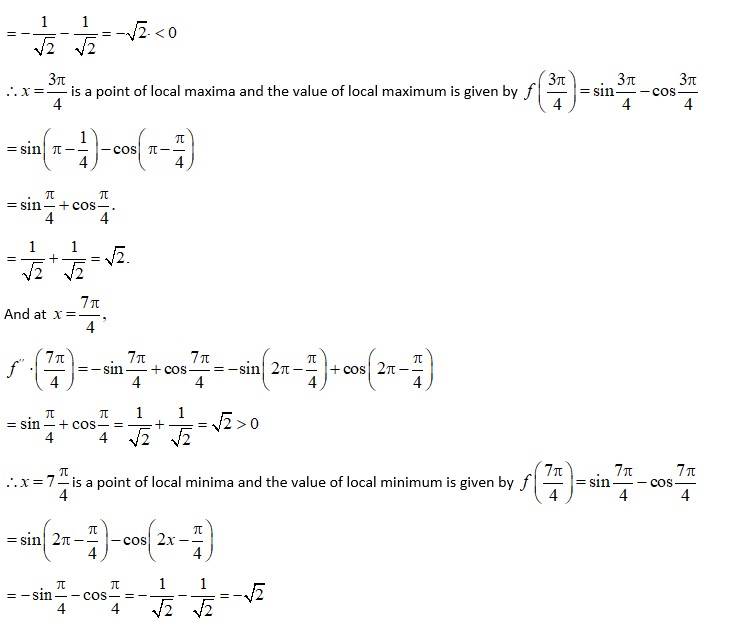
A(v)
we have, f(x) = x3- 6x2 + 9x + 15.
f(x) = 3x2- 12x + 9.
f'(x) = 6x - 12.
At extreme point, f'(x) = 0.
3x2- 12x + 9 = 0.
x2- 4x + 3 = 0
x2-x - 3x + 3 = 0
x(x - 1) -3(x - 1) = 0
(x - 1)(x - 3) = 0
x = 1 or x = 3.
At, x = 1,f"(1) = 6 × 1 - 12 = 6 - 12 = - 6 < 0
∴x = 1 is a point of local maxima and the value of local
Maximum is given by f(1) = 13- 6(1)2 + 9(1) + 15
= 1 - 6 + 9 + 15
= 19.
And at x = 3,f"(3) = 6 × 3 - 12 = 18 - 12 = 6 > 0
∴x = 3 is a point of local minima and the value of
local minimum is given by f (3) = 33- 6(3)2 + 9(3) + 15.
= 27 - 54 + 27 + 15.
= 15.
(vi)
A(vi)
We have,
At, extreme point, g'(x) = 0
x = -2 or x = 2
Given, that x > 0, hence we have x = 2.
At, x = 2,
∴x = 2 is a point of local minima and value of local
Minimum is given by g(2) =
(vii)
A(vii)
Given,
At extreme points, g'(x) = 0.
x = 0.
At, x = 0,
∴x = 0 is a point of local maxima and value of local maximum is given by
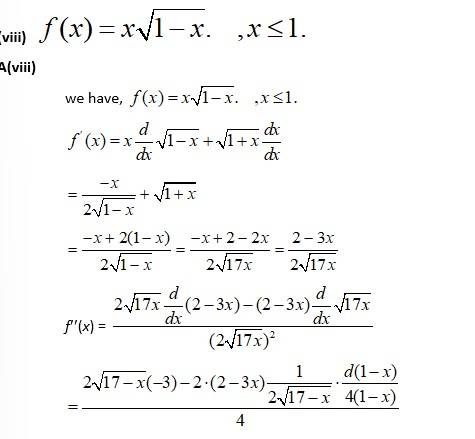
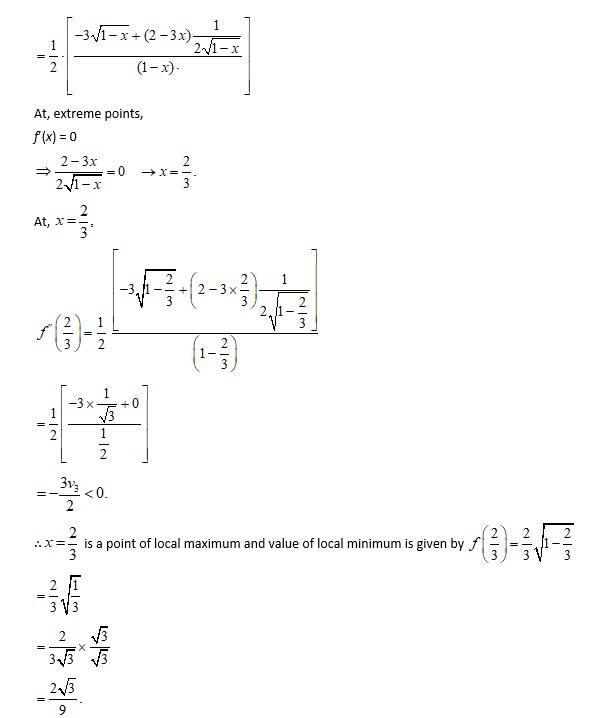
78. Find the absolute maximum value and the absolute minimum value of the following functions in the given intervals:
(i) f(x) =x3 , x ∈ [– 2, 2]
(i) We have,
f(x) = x3 , x ∈ [– 2, 2].
f(x) = 3x2.
At, f(x) = 0
3x2 = 0
x = 0 <--[-2, 2].
We shall absolute the value of f at x = 0 and points of interval [ -2, 2]. So,
f(0) = 0
f(- 2) = (- 2)3 = 8
f(2) = 23 = 8.
∴ Absolute maximum value of f(x) = 8 at x = 2
and absolute minimum value of f(x) = -8 at x = -2.
(ii) f (x) = sin x + cos x , x ∈ [0, π]
A.(ii)
We have, f(x) = sin x + cos x , x ∈ [0, π]
f(x) = cos x - sin x.
atf(x) = 0
cosx - sin x = 0
sinx = cos x
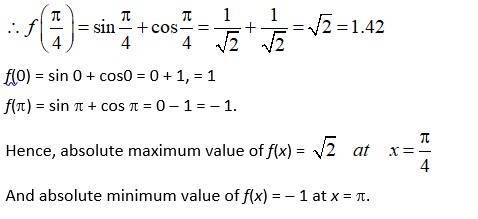
(iii) f(x) = 4x
A.(iii)
We have, f(x) = 4x
f(x) = 4 - x
atf(x) = 0
4- x = 0
x = 4
= 7.87.5
Hence, absolute maximum value of f(x) = 8 at x = 4
and absolute minimum value of f(x) = -10 at x = -2.
(iv) f(x) = (x - 1)2 + 3, x∈[ -3, 1]
A.(iv)
We have, f(x) = (x - 1)2 + 3, x∈[ -3, 1]
f(x) = 2(x -1)
atf(x) = 0
2(x - 1) = 0
x = 1∈ [ -3, 1]
∴f(1) = (1 - 1)2 + 3 = 3
f(- 3) = (- 3 - 1)2 + 3 = 16 + 3 = 1
∴ Absolute maximum value of f(x) = 19 at x = -3.
And absolute minimum value of f(x) = 3 at x = 1.
79. Find the ma proximumfit that a company can make, if the profit function is given by p(x) = 41 – 72x – 18x2
We have, p (x) = 41 -f2x - 18x2.
P (x) = - 72 - 36x
P (x) = -36
At extreme point,
- 72 - 36x = 0
.
At x = - 2, p" (x) = - 36 < 0.
∴x = -2 is a point of local maximum and the value of local
Maximum is given by P (2) = 41 - 72 (- 2) - 18 (- 2)2
41 + 144 - 72 = 113 units.
80. Find both the maximum value and the minimum value of 3x4 – 8x3 + 12x2 – 48x + 25 on the interval [0, 3].
We have, f (x) = 3x4- 8x3 + 12x2- 48x + 25, x ∈ [0, 3].
f (x) = 12x3- 24x2 + 24x - 48.
At f (x) = 0.
12x3- 24x2 + 24x - 48 = 0.
x3- 2x2 + 2x - 4 = 0
x2 (x - 2) + 2 (x - 2) = 0
(x - 2) + (x2 + 2) = 0
x = 2 ∈ [0, 3] or x = which is not possible as
∴f (x) = 3 (2)4- 8 (2)3 + 12 (2)2- 4 (2) + 25.
=48 - 64 + 48 - 96 + 25.
= -39.
f (0) =3 (0)4- 8 (0)3 + 12 (0)2- 48 (0) + 25.
= 25.
f (3) = 3 (3)4- 8 (3)3 + 12 (3)2- 48 (3) + 25.
= 243 - 216 + 108 - 144 + 25
= 16.
Maximum value of f (x) = 25 at x = 0.
and minimum value of f (x) = -39 at x = 2.
81. At what points in the interval [0, 2π], does the function sin 2x attain its maximum value?
We have, f(x) = sin 2x, x ∈ [0, 2π],
f(x) = 2cos 2x.
At f(x) = 0.
2 cos 2x = 0
cos 2x = 0
.
= 1.
= 1.
f(0) = sin 2(0) = sin 0 = 0
f(2π) = sin 2(2π) = sin 4π = 0
Hence, the points of maximum
Find the maximum value of the same function in [–3, –1]
We have, f (x) =2x3- 24x + 107, x [1,3]
f (x) = 6x2- 24.
At f (x) = 0
6x2- 24= 0
x = ±2. ->x = 2 ∈ [1, 3].
So, f (2) = 2 (2)3- 24 (2) + 107 = 16 - 48 + 107 = 75.
f (1) = 2 (1)3- 24 (1) + 107 = 2 - 24 + 107 = 85.
f (3) = 2 (3)3- 24 (3) + 107 = 54 - 72 + 107 = 89
∴ Maximum value of f (x) in interval [1, 3] is 89 at x = 3.
When x ∈ [ -3, -1]
From f (x) = 0
x = -2 ∈ [ -3, -1]
So, f (- 2) = 2 (- 2)3- 24 (- 2) + 107 = - 16 + 48 + 107 = 139.
f (- 3) = 2 (- 3)3- 24 (- 3) + 107 = - 54 + 72 + 107 = 125.
f (- 1) = 2 (- 1)3- 24 (- 1) + 107 = - 2 + 24 + 107 = 129.
∴ Maximum value of f (x) in interval [ -3, -1] is 139 at x = -2.
84. It is given that at x = 1, the function x4 – 62x2 + ax + 9 attains its maximum value, on the interval [0, 2]. Find the value of a.
We have, f (x) = x4- 62x2 + ax + 9, x∈ [0, 2].
f (x) = 4x3- 124x + a
∴f (x) active its maxn value at x = 1∈ [0, 2]
∴f (1) = 0.
4 (1)3- 124 (1) + a = 0
a = 124 - 4 = 120.
∴a = 120
86. Find two numbers whose sum is 24 and whose product is as large as possible.
Let ‘x’ and ‘y’ be the two number
Then, x + y = 24 y = 24 - x
Let ‘P’ be their product then,
P = xy = x (24 - x) = 24x -x2
P (x) = 24x -x2
At
24 - 2x = 0
So, P (12)
x = 12 is a point of local maxima
Hence, y = 24 - 12 = 12.
The uqdtwno (x, y) is (12, 12).
87. Find two positive numbers x and y such that x + y = 60 and xy3 is maximum.
We have, x + y = 60.where x, y > 0
x = 60 - y.
Let the product P = xy3 = (60 -y) y3 = 60y3-y4
= 4y2 (45 -y)
At
4y2 (45 -y) = 0
y = 0 and y = 45
As y > 0, y = 45
When, y > 45,
= ve < 0
Ad y < 45,
= (+ ve) > 0
∴p is maximum when y = 45 from + ve to- ve or y increases through 45.
So, x = 60 - y = 6Ø - 45 = 15.
Øx = 15 and y = 45.
88. Find two positive numbers x and y such that their sum is 35 and the product x2 y5 is a maximum.
We have, x + y = 35.
y = 35 - x
Let the product, P =x2 y5
P = x2 (35 -x)5
So, = x2 5 (35 -x)4 (1) + (35 -x)5 2x
= x (35 -x)4 [ - 5x + (35 -x) 2]
= x (35 -x)4 [ - 5x + 70 - 2x]
= x (35 -x)4 (70 - 7x)
= 7x (35 -x)4 (10 -x)
At
7x (35 -x)4 (10 -x) = 0
x = 0, 35, 10
As x is a (+) ve number we have only
x = 10, 35
And again (at x = 35) y = 35 = 0 but yis also a (+) ve number
we get, x = 10 (only)
whenx < 10,
and when x > 10,
changes from (+ ve) to ( -ve) as x increases while passing through 10
Hence, x = 10 is a point of local maxima
So, y = 35 - 10 = 25
∴x = 10 and y = 25
89. Find two positive numbers whose sum is 16 and the sum of whose cubes is minimum
Let, x and y be the two positive number
Then, x + y = 16 y = 16 - x
Let p be the sun of the cubes then
p = x3 + y3 = x3 + (16 -x)3 = x3 + (16)3-x3- 48x (16 -x)
p = 163 + 48x2- 76 8x
So,
At
96x - 768 = 0
∴at x = 8,
So, x = 8 is a point of local minima
So, y = 16 - 8 = 8
Hence, x = 8, y = 8
90. A square piece of tin of side 18 cm is to be made into a box without top, by cutting a square from each corner and folding up the flaps to form the box. What should be the side of the square to be cut off so that the volume of the box is the maximum possible.
Side of the tin square piece = 18 cm
Let x cm be the thought of the square to be cut from each corner.
The volume v of the box after cutting
v = length × breadth × height
= (18 - 2x) (18 - 2x) x x
= (18 - 2x)2x
= (324 + 4x2- 72x) x
= 4x3- 72x2 + 324x
So,
As
x2- 12x + 27 = 0
x2- 9x- 3x + 27 = 0
x (x - 9) - 3 (x - 9) = 0
(x - 9) (x - 3) = 0
x = 9 and x = 3
At x = 0, length of box = 18 - 2π9 = 18 - 18 = 0
Which is not possible
And at x = 3, = 24 (3) - 144 = -72 < 0
∴x = 3 is a point of maximum
Hence, ‘3’ cm (square) is to be cut from each side of the square
So that volume of box is maximum
91. A rectangular sheet of tin 45 cm by 24 cm is to be made into a box without top, by cutting off square from each corner and folding up the flaps. What should be the side of the square to be cut off so that the volume of the box is maximum?
Let ‘x’ cm be the length of side of the square to be cut off from the rectangular surface
Then, the volume v of the box is v = (45 - 2x) (24 - 2x) x
= 1080x - 138x2 + 4x3
So,
At,
x2- 23x + 90 = 0
x2- 5x - 18x + 90 = 0
x (x - 5) - 18 (x - 5) = 0
(x- 5) (x- 18) = 0
x = 5 and x = 18
At x = 18, breadth = 24 - 2 (18) = 24 - 36 = -12 which is not possible
At,
Hence, x = 5 is the point of maximum
So, ‘5’ cm length of square seeds to be cut from each corner of the secthgle
93. Show that the right circular cylinder of given surface and maximum volume is such that its height is equal to the diameter of the base.
Let r and h be the radius and height of the cylinder
So, r, h > 0
The total surface area s is given by
S = 2πr(h + r) = content .
= content = x (say)
Then, the volume v of the cylinder
So,
For maximum,
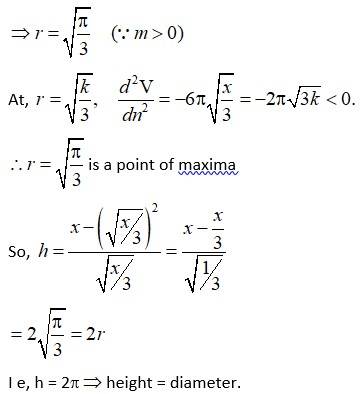
94. Of all the closed cylindrical cans (right circular), of a given volume of 100 cubic centimetres, find the dimensions of the can which has the minimum surface area?
The volume v of a cylinder of height h and radius r is
V = πr2h = 100
Let, s be the surface area then
S = 2r2hr(r + h) =
At,
At,
isa point of minimum
And
95. A wire of length 28 m is to be cut into two pieces. One of the pieces is to be made into a square and the other into a circle. What should be the length of the two pieces so that the combined area of the square and the circle is minimum?
Let x and y in ‘m’ be the length of side of the square the radius of the circle respectily
Then, length of wire = perimeter of square + circumference of circle
28 = 4x + 2πy
2x + πy = 14
The combine area A of the square and the circle is
A = x2 + πy2
So,
At,
At,
isa point of minima
Hence, length of square =
and length of circle = 2πy
96. Prove that the volume of the largest cone that can be inscribed in a sphere of radius R is of the volume of the sphere.
Let r and h be the radius and height of the one in scribed in the sphere of radius R.
Then, is ΔOBC, rt angle at B (h-r)2 + r2 = R2
h2 + R2- 2hR + h2 = R2
r2 = 2hR -h2
Then the volume v of the cone is,
At
4Rh – 3h2 = 0.
h(4R – 3h) = 0.
h = 0 and
As h> 0,
At
is a point of maxima.
and
Hence, Volume of Cone,
Volume of sphere.
98. Show that the semi-vertical angle of the cone of the maximum volume and of given slant height is √2.
Let r, h, l and Ø be the radius, height, slant height and semi-vertical angle respectively of the cone. i.e., r, h, l>0.
Then, Volume V of the cone is
So,
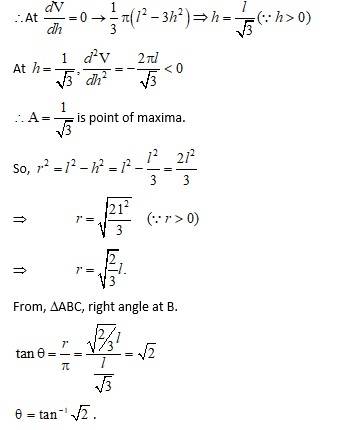
100. The point on the curve x2 = 2y which is nearest to the point (0, 5) is
(A) (2√2 ,4) (B) (2√2 ,0) (C) (0, 0) (D) (2, 2)
The equation of the given curve is
x2 = 2y.
Let p (x, y) be a point on the curve.
The distance of p (x, y) from (0, 5) is say S is given by

Let z = s2 = x2 + y2 + 25 – 10y = 2y + y2 -10y + 25
z = y2 – 8y + 25
So,
At
At y = 4,
y = 4, is point of minimum distance.
So, x2 = 2y->x2 = 2 × 4-> x2 = 8
Hence, the point of the nearest distance are and
Option (A) is correct.
101. For all real values of x, the minimum value of is
(A) 0 (B) 1 (C) 3 (D)
We have,
At f(x) = 0.
x = 1 and x = -1.
At
At x = -1,
The maximum value of f(x)
Hence, option (D) is correct.
102. The maximum value of , 0
(A) (B) (C) 1 (D) 0
We have,
At f(x) = 0.
2x – 1 = 0
=
Option (B) is
Hence maximum value of f(x) = at x = 1 and x = 0.
Option (c) is correct.
103. Using differentials, find the approximate value of each of the following
(a)
(a) Consider
Now, is approximately equal to and is given by,
Hence, the approximate value of is
=0.677
(b)
(b) Consider

Now, is approximately equal to and is given by,
Hence, the approximate value of
is
104. Show that the function given by has maximum at x = e.
We have, f(x)
f(x) =
f(x) =
=
= =
At extreme points, f(x) = 0.
At x = e, f"(e) =
x = e is a point of maximum.
105. The two equal sides of an isosceles triangle with fixed base b are decreasing at the rate of 3 cm per second. How fast is the area decreasing when the two equal sides are equal to the base ?
Let ‘b’ and ‘x’ be the fixed base and equal side of isosceales triangle.
Then, cm/s (Ø decreasing).
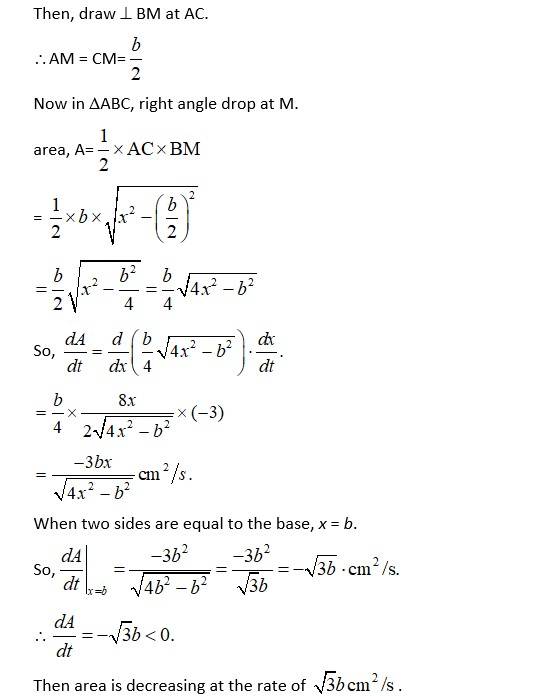
106. Find the equation of the normal to curve x2 = 4y which passes through the point (1, 2)
Equation of the curve is
Now, the slope of the normal at point is
Equation of the normal at is
107. Show that the normal at any point θ to the curve x = a cosθ + a θ sin θ, y = a sinθ – aθ cosθ is at a constant distance from the origin.
We have
Slope of the normal at any point is
The equation of the normal at a given point is given by,
Now, the perpendicular distance of the normal from the origin is

f(x)= is (i) increasing (ii) decreasing
We have, f(x)=
So,
Now,
And, as cos x lies in [1, 1].
So, (i) for increasing, f(x) ≥ 0.
cosx ≥ 0.
x lies in Ist and IVth quadrant.
i.e., f(x) is increasing for and
(ii) for decreasing, f(x) ≤ 0.
cosx ≤ 0.
x lies in IInd and IIIrd quadrant.
i.e., f(x) is decreasing for .
109. Find the intervals in which the function f given by is
(i) Increasing (ii) Decreasing
We have, f(x) =
{
At
So we have three disjoint internal i.e.,
When,
So, f(x) is increasing.
When
So, f(x) is decreasing.
When
f(x) =
So, f(x) is increasing.
f(x) is increasing for x(∞,1) and [1, ∞] and decreasing for x[1, 1].
110. Find the maximum area of an isosceles triangle inscribed in the ellipse
with its vertex at one end of the major axis.
The given equation of the ellipse is (1)
Let the major axis be along x-axis so, vertex is at
Let ΔABC be the isosceles triangle inscribed on the
ellipse with one vertex C at (a, 0).
Then, let A have Co-ordinate (x0, yo) from figure.
So, Co-ordinate of B = (x0, y0)
As A and B lies on the ellipse, from equation (i),
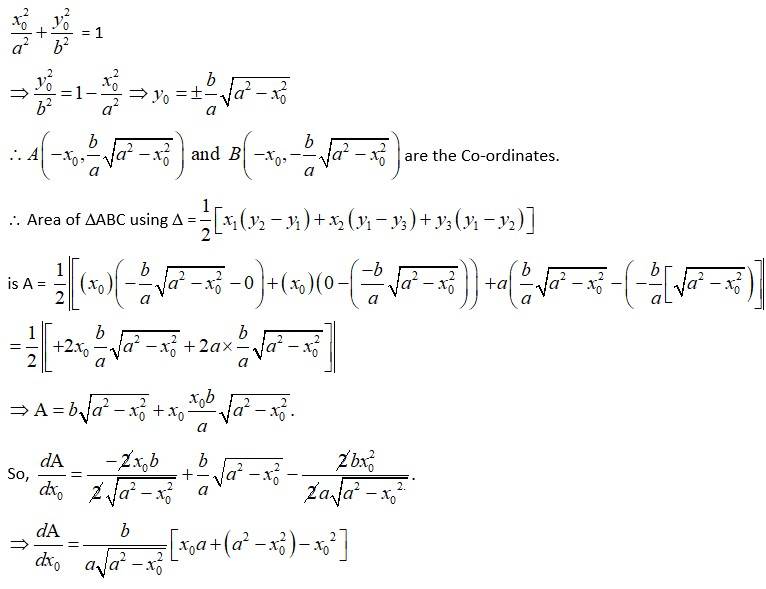
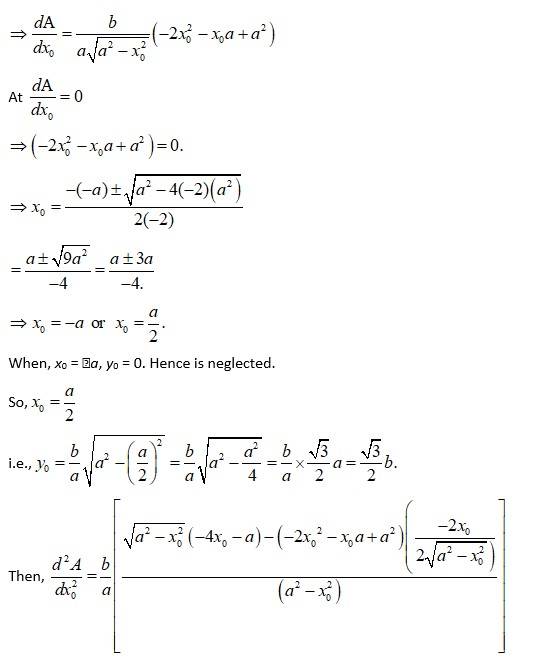
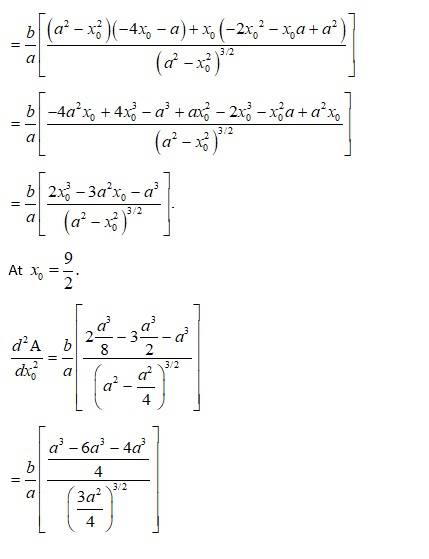
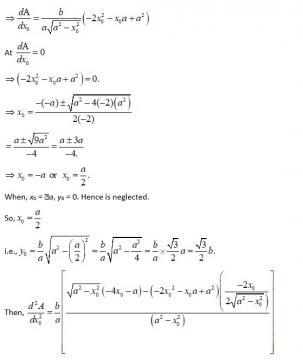
111. A tank with rectangular base and rectangular sides, open at the top is to be constructed so that its depth is 2 m and volume is 8 m3. If building of tank costs Rs 70 per sq metres for the base and Rs 45 per square metre for sides. What is the cost of least expensive tank?
Let x and y meters be the length and breath of the rectangular base of the tank respectively.
Then, volume V of the tank is
V = length × depth × breath.
V = 2xy = 8m3(given).
Let ‘t’ be the total cost of building the tank.
Then, t = cost of base + cost of sides.
= 70xy + 45[4x+4y] {there are four sides.
= 70xy + 180x+ 180y.
=
So,
And
At
x = ± 2
x = 2, (x = length and it cannot be negative)
At x = 2,
x = 2 is point of maxima.
Hence, minimum cost = = 280 + 360 + 360 = 1000.
112. The sum of the perimeter of a circle and square is k, where k is some constant. Prove that the sum of their areas is least when the side of square is double the radius of the circle.
Let r and s be the radius of the circle and length of side of square.
Then, sum of perimeter of circle and square = k
2πr +4s = k
s =
The area A be the total areas of the circle and square.
Then, A = πr2 + s2
So,
And
At
At
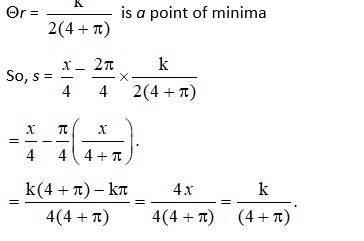
s =
s = 2r.
Hence, proved.
113. A window is in the form of a rectangle surmounted by a semicircular opening. The total perimeter of the window is 10 m. Find the dimensions of the window to admit maximum light through the whole opening.
Let ‘x’ metre be the radius of the semi-circular opening mounded on the length ‘2x’ side of rectangle. Then, let ‘y’ be the breadth of the rectangle.
Then, perimeter of the window = 10m
x + 2x + 2y + = 10.
Let the area of the window be A.
Then, A =
= [-πx2- 4x2 + 20x].
So, [ -2πx - 8x + 20]
And [ -2π - 8] = -π -4 = -( π+ 4)
At
[ -2πx - 8x + 20] = 0
2x + 8x = 20
x = =
At x = = -( π+ 4) < 0
Øx = is a point of minima.
And y =
Ø Dimensions of the window are
length = 2x =
breadth = y
radius = y =
114. A point on the hypotenuse of a triangle is at distance a and b from the sides of the triangle. Show that the minimum length of the hypotenuse is
.
Let P be the point on hypotenuse of a triangle. ABC, t angle at B.
Which is at distance a& b from the sides of the triangle.
Let < BAC = < MPC = Ø.
Then, in… ΔANP,
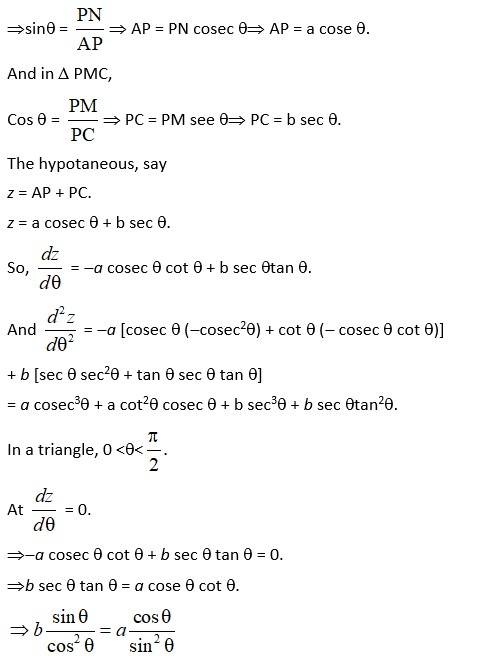
At tan Ø =
{ Øall trigonometric fxn are + ve in Ist quadrant}.
So, z is least for tanØ =
As, Sec2Ø = 1 + tan2Ø = 1 + =
secØ = =
And tan2Ø =
cot2Ø =
And cosec2Ø = 1 + cot2Ø = 1 + =
cosecØ =
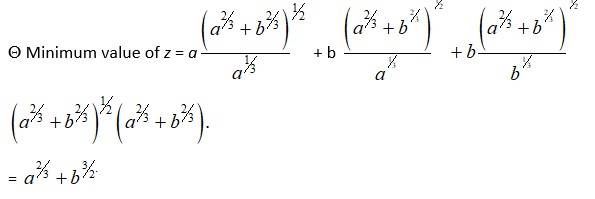
115. Find the points at which the function f given by f (x) = (x – 2)4 (x + 1)3 has (i) local maxima (ii) local minima (iii) point of inflexion
We have,
f (x) = (x- 2)4 (x + 1)3.
So, f (x) = (x- 2)4. 3 (x + 1)2 + (x + 1)3. 4 (x- 2)3.
= (x- 2)3 [x + 1)2 [3 (x- 2) + 4 (x + 1)]
= (x- 2)3 (x + 1)2 (3x- 6 + 4x + 4)
= (x- 2)3 (x + 1)2 (7x- 2).
At f (x) = 0.
(x- 2)3 (x + 1)2. (7x- 2) = 0.
x = 2, x = -1 or x =
As (x + 1)2> 0, we shave evaluate for the remaining factor.
At x = 2,
When x< 2, f (x) = ( -ve) (+ ve) (+ ve) = ( -ve) < 0.
When x> 2, f (x) = (+ ve) (+ ve) (+ ve) = (+ ve) > 0.
Øf (x) change from ( -ve) to (+ ve) as x increases
So, x = 2 is a point of local minima
At x = -1.
When x< -1, f (x) = ( -ve) (+ ve) ( -ve) =∉, ve > 0.
When x> -1, f (x) = ( -ve) (+ ve) (+ ve) =∉, ve > 0.
So, f (x) does not change through x -1.
Hence, x = -1 is a point of infixion
At x =
When x< f (x) = ( -ve) (+ ve) ( -ve) = ( -ve > 0.
When x< f (x) = ( -ve) (+ ve) (+ ve) = ( -ve < 0.
f (x) change from (+ ve) to ( -ve) as x increases through
x = is a point of local maxima
116. Find the absolute maximum and minimum values of the function f given by f (x) =cos2 x + sin x, x ∈ [0, π]
We have,
f (x) = cos2x + sin x, x∈ [0, π ].
So, f (x) = 2 cos x ( -sin x) + cos x = cos x (1 - 2 sin x).
At f (x) = 0
cosx (1 - 2 sin x) = 0
cosx = 0 or 1 - 2 sin x = 0
cosx = cos or sin x = = sin = sin
x= , x = and x = [0, π ].
So, f = cos2 + sin = 1.
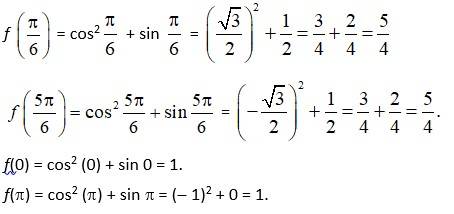
Absolute minimum of f (x) = and absolute minimum of f (x) = 1.
117. Show that the altitude of the right circular cone of maximum volume that can be inscribed in a sphere of radius r is .
Let x be the radius of the sphere ad x be radius of the right circular cone.
Let height of cone = y
Then, in ΔOBA,
(y-r)2 + x2 = r2
y2 + r2- 2ry + x2 = r2
x2=2ry - y2
So, the volume V of the cone is
So,
And
At
4x -y- 3y2 = 0
asy> 0.
At y = =
Ø V is maximum when y =
118. Let f be a function defined on [a, b] such that f ′(x) > 0, for all x ∈ (a, b).
Then prove that f is an increasing function on (a, b).
We have,
f (x) defined on [a, b]
And f (x) > 0 ∀ x ∈ [a, b].
Let x1, x2 ∈ [a, b] and x2>x1
In the internal x1, x2], f (x) will also be continuous and differentiable.
Hence by mean value theorem, there exist c [x1, x2] such that
f (x) > 0 ∀ x ∈ [a, b].
Then, f (c) > 0.
i.e., f (x2) -f (x1) > 0
f (x2) >f (x1).
Hence, the function f (x) is always increasing on [a, b]
119. Show that the height of the cylinder of maximum volume that can be inscribed in a sphere of radius R is 2R/√3. Also find the maximum volume.
Kindly go through the solution
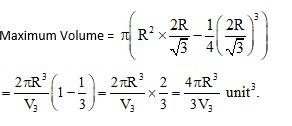
121. A cylindrical tank of radius 10 m is being filled with wheat at the rate of 314 cubic metre per hour. Then the depth of the wheat is increasing at the rate of (A) 1 m/h (B) 0.1 m/h (C) 1.1 m/h (D) 0.5 m/h
Let x be the depth of the wheat inside the cylindrical tank is with radius = 10 cm
Then, Volume V of the cylindrical tank is
V = π (10)2x = 100πpx m3
As
i e, rate of increasing of depth
option (A) is correct
124. The normal to the curve x2 = 4y passing (1,2) is (A) x + y = 3 (B) x – y = 3 (C) x + y = 1 (D) x – y = 1
The equation of the given curve is
Differentiating with respect to x, we have:
The slope of the normal to the given curve at point (h,k) is given by,
Equation of the normal at point (h,k) is given as:
Now, it is given that the normal passes through the point (1,2).
Therefore, we have:
Since (h,k) lies on the curve ,we have
From equation (i), we have:
Hence, the equation of the normal is given as:
Therefore, option (A) is correct.
125. The points on the curve 9y2 = x3 , where the normal to the curve makes equal intercepts with the axes are
(A) (B) (C) (D)
The equation of the given curve is
Differentiate with respect to x, we have:
The slope of the normal to the given curve at point is
The equation of the normal to the curve at is
It is given that the normal makes intercepts with the axes.
Therefore, we have:
Also, the point lies on the curve, so we have
From (i) and (ii), we have:
From (ii), we have:
Hence, the required points are .
Therefore, option (A) is correct.
36. Prove that the function given by f (x) = x3 – 3x2 + 3x – 100 is increasing in R.
We have, f (x) = x3- 3x2 3x- 100.
So, f (x) = 3x2- 6x + 3 = 3 (x2- 2x + 1) = 3 (x- 1)2
For
(x- 10)2 , 0 for x = 1.
3 (x- 1)2
f (x)
∴f (x) is increasing on
77. Prove that the following functions do not have maxima or minima:
(i) f(x) = ex
(i) We have, f (x) = ex
f (x) = ex.
At, extreme points,
f (x) = 0
ex = 0 which has no real ‘a’ value
∴f (x) has with maximum or minima
(ii) g (x) = log x
A (ii)
We have, g (x) = log x,
g (x) =
At extreme points,
g (x) = 0
1 = 0 which is not true.
∴g (x) was value minima or maxima
(iii) h (x) = x3 + x2 + x + 1.
A (iii)
We have, h (x) = x3 + x2 + x + 1.
h (x) = 3x2 + 2x + 1
At extreme points,
h (x) = 0
3x2 + 2x + 1 = 0
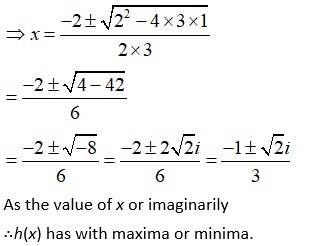
NCERT Solutions for Class 12 Maths Ch 6 Application of Derivatives- FAQs
Check few of the most asked questions related to this chapter by students below;
Class 12 Application of Derivatives 6.5 Solutions- (Old NCERT)
Class 12 Math Application of Derivatives Exercise 6.5 mainly focuses on problems such as finding minimum and maximum values of various types of functions, finding minima and maxima on a given point of functions, real real-world problems ( finding minimum and maximum profit), and finding values of volume, area, and more in a given interval for function. The Class 12 Exercise 6.5 Solutions will guide students about approaches, critical thinking skills, first and second derivative tests, and their applications in optimization. Application of Derivatives Exercise 6.5 consists of 29 Questions including 15 Long, 11 Short, and 3 MCQs. Students can check the complete solutions of the exercise 6.5 below;
Application of Derivative Exercise 6.5 Solutions
| Q74.Find the maximum and minimum values, if any, of the following functions given by. (i) |
| A(i) We have, f(x) = (2x - 1)2 + 3. For all (2x - 1)2 + 3 ≥ 3. f(x) ≥ 3. ∴The minimum value of f(x) = 3. When 2x - 1 = 0--> x = Again as as there is vouppa bound to ‘x’ value hence, f(x) has no maximum values. (ii) A(ii) We have, f(x) = 92 + 12x + 2. (Taking 9 common from each team).
For all
f(x)≥ - 2. ∴The minimum value of f(x) = -2 when And as so f(x) has no maximum values. (iii) f(x) = (x - 1)2 + 10 A(iii) we have, f(x) = - (x - 1)2 + 10 For all (x - 1)2 ≤ 0 -(x- 1)2 + 10 ≤ 10. f(x) ≤ 10. ∴maximum value of f(x) = 10 when x - 1 = 0 x = 1. And minimum value of f(x) does not exist. (iv) g(x) = x3 + 1 A(iv) we have, g(x) = x3 + 1 For the given fxn,
and Q Maximum and minimum value does not exist. |
| Q75. Find the maximum and minimum values, if any, of the following functions given by (i) f(x) = |x + 2| - 1 |
| A(i) we have, f(x) = |x + 2| - 1 We know that, for all
f(x) - 1. ∴ Minimum value of f(x) = -1 when x + 2 = 0 x = - 2. And maximum value of f(x) does not exist. (ii) A(ii) We have, For all
g(x) 3. ∴ Maximum value of g(x) = 3 when And minimum value does not exist. (iii) h(x) = sin (2x) + 5. A(iii) we have, h(x) = sin (2x) + 5. For all {range of sine function is [-1, 1]} -1 + 5 sin 2x + 5 1 + 5. 4 h(x) 6. ∴ Maximum value of h(x) = 6. Minimum value of h(x) = 4. (iv) A(iv) we have, As for all -1 + 3 sin 4x + 3 1 + 3
2 f(x) 4. ∴ Maximum value of f(x) = 4. Minimum value of f(x) = 2. (v) h(x) = x + 1.,x∈ ( -1, 1). A(v) we have, h(x) = x + 1.,x∈ ( -1, 1). Given, -1
- 1 + 1 <x + 1 < 1 + 1 0 <h (x) < 2. ∴ Maximum value and minimum value of h(x) does not exist. |
| Q76. Find the local maxima and local minima, if any, of the following functions. Find also the local maximum and the local minimum values, as the case may be: (i) f(x) = x2. |
| A(i) we have, f(x) = x2. f(x) = 2x. andf(x) = 2. AR extreme point, f(x) = 0 2x = 0 x = 0. When x = 0, f(0) = 2 > 0. ∴x = 0 is a point of local minima and value of local minimum is given by f(0) = 02 = 0. (ii) g(x) = x3 3x A(ii) we have, g(x) = x3- 3x g'(x) = 3x2- 3 g''(x) = 6x. At extreme point, g'(x) = 0 3x2- 3 = 0. 3(x2- 1) = 0 ⇒ 3(x - 1)(x + 1) = 0. x = 1 or x = -1. At x = 1, g"(1) = 6.1 = 6 > 0. So, x = 1 is a point of local minima and value of local minimum is given by g(1) = 13- 3.1 = 1 - 3 = - 2. And at x = -1, g"( -1) = 6 ( -1) = 6 < 0. So, x = -1 is a point of local minima and value of local minimum is given by g(- 1) = (- 1)3- 3(- 1) = 1 + 3 = 2. (iii) A(iii) we have, h(x) = sin x + cos x. h'(x) = cos x - sin x h'(x) = -sin x - cos x. At extreme points, h'(x) = 0 cosx - sin x = 0 cosx = sin x
1 = tan x
(iv) A(iv) we have, f(x) = sin x cos x. f(x) = cos x + sin x f(x) = sin x + cos x. At extreme points, f(x) = 0 cosx + sin x = 0.
IInd quadrate or IIIth quadrate
A(v) we have, f(x) = x3- 6x2 + 9x + 15.
At extreme point, f'(x) = 0.
At, x = 1,f"(1) = 6 × 1 - 12 = 6 - 12 = - 6 < 0 ∴x = 1 is a point of local maxima and the value of local Maximum is given by f(1) = 13- 6(1)2 + 9(1) + 15 = 1 - 6 + 9 + 15 = 19. And at x = 3,f"(3) = 6 × 3 - 12 = 18 - 12 = 6 > 0 ∴x = 3 is a point of local minima and the value of local minimum is given by f (3) = 33- 6(3)2 + 9(3) + 15. = 27 - 54 + 27 + 15. = 15. (vi)
A(vi) We have,
At, extreme point, g'(x) = 0
Given, that x > 0, hence we have x = 2. At, x = 2,
∴x = 2 is a point of local minima and value of local Minimum is given by g(2) =
(vii)
A(vii) Given,
At extreme points, g'(x) = 0.
At, x = 0,
∴x = 0 is a point of local maxima and value of local maximum is given by
|
| Q77. Prove that the following functions do not have maxima or minima: (i) f(x) = ex |
| A(i) We have, f(x) = ex
At, extreme points, f(x) = 0
∴f(x) has with maximum or minima (ii) g(x) = log x A(ii) We have, g(x) = log x,
At extreme points, g(x) = 0
∴g(x) was value minima or maxima (iii) h(x) = x3 + x2 + x + 1. A(iii) We have, h(x) = x3 + x2 + x + 1. h(x) = 3x2 + 2x + 1 At extreme points, h(x) = 0
|
| Q78. Find the absolute maximum value and the absolute minimum value of the following functions in the given intervals: (i) f(x) =x3 , x ∈ [– 2, 2] |
| A.(i) We have, f(x) = x3 , x ∈ [– 2, 2]. f(x) = 3x2. At, f(x) = 0 3x2 = 0 x = 0 <--[-2, 2]. We shall absolute the value of f at x = 0 and points of interval [ -2, 2]. So, f(0) = 0 f(- 2) = (- 2)3 = 8 f(2) = 23 = 8. ∴ Absolute maximum value of f(x) = 8 at x = 2 and absolute minimum value of f(x) = -8 at x = -2. (ii) f (x) = sin x + cos x , x ∈ [0, π] A.(ii) We have, f(x) = sin x + cos x , x ∈ [0, π] f(x) = cos x - sin x. atf(x) = 0
(iii) f(x) = 4x
A.(iii) We have, f(x) = 4x
f(x) = 4 - x atf(x) = 0
= 7.87.5 Hence, absolute maximum value of f(x) = 8 at x = 4 and absolute minimum value of f(x) = -10 at x = -2. (iv) f(x) = (x - 1)2 + 3, x∈[ -3, 1] A.(iv) We have, f(x) = (x - 1)2 + 3, x∈[ -3, 1] f(x) = 2(x -1) atf(x) = 0 2(x - 1) = 0 x = 1∈ [ -3, 1] ∴f(1) = (1 - 1)2 + 3 = 3 f(- 3) = (- 3 - 1)2 + 3 = 16 + 3 = 1 ∴ Absolute maximum value of f(x) = 19 at x = -3. And absolute minimum value of f(x) = 3 at x = 1. |
| Q79. Find the ma proximumfit that a company can make, if the profit function is given by p(x) = 41 – 72x – 18x2 |
| A.6. We have, p(x) = 41 -f2x - 18x2. P(x) = - 72 - 36x P(x) = -36 At extreme point, - 72 - 36x = 0
At x = - 2, p"(x) = - 36 < 0. ∴x = -2 is a point of local maximum and the value of local Maximum is given by P(2) = 41 - 72(- 2) - 18(- 2)2 41 + 144 - 72 = 113 units. |
| Q80. Find both the maximum value and the minimum value of 3x4 – 8x3 + 12x2 – 48x + 25 on the interval [0, 3]. |
| A7. We have, f(x) = 3x4- 8x3 + 12x2- 48x + 25, x ∈ [0, 3]. f(x) = 12x3- 24x2 + 24x - 48. At f(x) = 0. 12x3- 24x2 + 24x - 48 = 0. x3- 2x2 + 2x - 4 = 0 x2(x - 2) + 2(x - 2) = 0 (x - 2) + (x2 + 2) = 0 x = 2 ∈ [0, 3] or x =
∴f(x) = 3(2)4- 8(2)3 + 12(2)2- 4(2) + 25. =48 - 64 + 48 - 96 + 25. = -39. f(0) =3(0)4- 8(0)3 + 12(0)2- 48(0) + 25. = 25. f(3) = 3(3)4- 8(3)3 + 12(3)2- 48(3) + 25. = 243 - 216 + 108 - 144 + 25 = 16. Maximum value of f(x) = 25 at x = 0. and minimum value of f(x) = -39 at x = 2. |
| Q81. At what points in the interval [0, 2π], does the function sin 2x attain its maximum value? |
| A8. We have, f(x) = sin 2x, x ∈ [0, 2π], f(x) = 2cos 2x. At f(x) = 0. 2 cos 2x = 0 cos 2x = 0
= 1.
f(0) = sin 2(0) = sin 0 = 0 f(2π) = sin 2(2π) = sin 4π = 0 Hence, the points of maximum
|
| Q82. What is the maximum value of the function sin x + cos x? |
| A9. We have, f(x) = sin x + cos x. f(x) = cos x - sin x. At f(x) = 0 cosx - sin x = 0 sinx = cos x
At
|
|
Find the maximum value of the same function in [–3, –1] |
| A.10. We have, f(x) =2x3- 24x + 107, x[1,3] f(x) = 6x2- 24. At f(x) = 0 6x2- 24= 0
x = ±2. -->x = 2 ∈[1, 3]. So, f(2) = 2(2)3- 24(2) + 107 = 16 - 48 + 107 = 75. f(1) = 2(1)3- 24(1) + 107 = 2 - 24 + 107 = 85. f(3) = 2(3)3- 24(3) + 107 = 54 - 72 + 107 = 89 ∴ Maximum value of f(x) in interval [1, 3] is 89 at x = 3. When x ∈ [ -3, -1] From f(x) = 0 x = -2 ∈ [ -3, -1] So, f(- 2) = 2(- 2)3- 24(- 2) + 107 = - 16 + 48 + 107 = 139. f(- 3) = 2(- 3)3- 24(- 3) + 107 = - 54 + 72 + 107 = 125. f(- 1) = 2(- 1)3- 24(- 1) + 107 = - 2 + 24 + 107 = 129. ∴ Maximum value of f(x) in interval [ -3, -1] is 139 at x = -2. |
| Q84. It is given that at x = 1, the function x4 – 62x2 + ax + 9 attains its maximum value, on the interval [0, 2]. Find the value of a. |
| A.11. We have, f(x) = x4- 62x2 + ax + 9, x∈ [0, 2].
∴f(x) active its maxn value at x = 1∈ [0, 2] ∴f(1) = 0. 4(1)3- 124(1) + a = 0
∴a = 120 |
| Q85. Find the maximum and minimum values of x + sin 2x on [0, 2π]. |
| A.12. We have, f(x) = x + sin 2x ,x ∈ [0, 2π]. f(x) = 1 + 2cos 2x At f(x) = 0 1 + 2 cos2x = 0
Hence,
Missing At
= 1.05 + 0.87 = 1.92 At
= 1.23 At
=5.07. At
= 5.25 - 0.87 = 4.38 At and points, f(0) = 0 + sin2 × 0 = 0 f(2π) = 2π + sin 2 × 2π = 6.2 + 0 = 6.28 ∴Maximum value of f(x) = 6.28 at x = 2π and minimum value of f(x) = 0 at x= 0 |
| Q86. Find two numbers whose sum is 24 and whose product is as large as possible. |
| A.13. Let ‘x’ and ‘y’ be the two number Then, x + y = 24
Let ‘P’ be their product then, P = xy = x (24 - x) = 24x -x2 P(x) = 24x -x2
At
24 - 2x = 0
So, P(12)
x = 12 is a point of local maxima Hence, y = 24 - 12 = 12. The uqdtwno (x, y) is (12, 12). |
| Q87. Find two positive numbers x and y such that x + y = 60 and xy3 is maximum. |
| A.14. We have, x + y = 60.where x, y > 0 x = 60 - y. Let the product P = xy3 = (60 -y) y3 = 60y3-y4
= 4y2(45 -y) At
As y > 0, y = 45 When, y > 45,
= ve < 0 Ad y < 45,
= (+ ve) > 0 ∴p is maximum when y = 45 from + ve to- ve or y increases through 45. So, x = 60 - y = 6Ø - 45 = 15. Øx = 15 and y = 45. |
| Q88. Find two positive numbers x and y such that their sum is 35 and the product x2 y5 is a maximum. |
| A.15. We have, x + y = 35. y = 35 - x Let the product, P =x2 y5
So,
= x (35 -x)4[ - 5x + (35 -x) 2] = x (35 -x)4 [ - 5x + 70 - 2x] = x (35 -x)4 (70 - 7x) = 7x (35 -x)4 (10 -x) At
As x is a (+) ve number we have only x = 10, 35 And again (at x = 35) y = 35 = 0 but yis also a (+) ve number we get, x = 10 (only) whenx < 10,
and when x > 10,
Hence, x = 10 is a point of local maxima So, y = 35 - 10 = 25 ∴x = 10 and y = 25 |
| Q89. Find two positive numbers whose sum is 16 and the sum of whose cubes is minimum |
| A.16. Let, x and y be the two positive number Then, x + y = 16 y = 16 - x Let p be the sun of the cubes then p = x3 + y3 = x3 + (16 -x)3 = x3 + (16)3-x3- 48x (16 -x) p = 163 + 48x2- 76 8x So,
At
96x - 768 = 0
∴at x = 8,
So, x = 8 is a point of local minima So, y = 16 - 8 = 8 Hence, x = 8, y = 8 |
| Q90. A square piece of tin of side 18 cm is to be made into a box without top, by cutting a square from each corner and folding up the flaps to form the box. What should be the side of the square to be cut off so that the volume of the box is the maximum possible. |
| A.17. Side of the tin square piece = 18 cm Let x cm be the thought of the square to be cut from each corner. The volume v of the box after cutting
= (18 - 2x)(18 - 2x) x x = (18 - 2x)2x = (324 + 4x2- 72x) x = 4x3- 72x2 + 324x So,
As
At x = 0, length of box = 18 - 2π9 = 18 - 18 = 0 Which is not possible And at x = 3,
∴x = 3 is a point of maximum Hence, ‘3’ cm (square) is to be cut from each side of the square So that volume of box is maximum |
| Q91. A rectangular sheet of tin 45 cm by 24 cm is to be made into a box without top, by cutting off square from each corner and folding up the flaps. What should be the side of the square to be cut off so that the volume of the box is maximum? |
| A.18. Let ‘x’ cm be the length of side of the square to be cut off from the rectangular surface Then, the volume v of the box is v = (45 - 2x)(24 - 2x) x = 1080x - 138x2 + 4x3 So,
At,
At x = 18, breadth = 24 - 2(18) = 24 - 36 = -12 which is not possible At,
Hence, x = 5 is the point of maximum So, ‘5’ cm length of square seeds to be cut from each corner of the secthgle |
| Q92. Show that of all the rectangles inscribed in a given fixed circle, the square has the maximum area. |
| A.19. Let A.B.C.D.be the square increased in a given fixed circle with radius x Let ‘x’ and ‘y’ be the length and breadth of the rectangle ∴x, y> 0 In ABC, right angle at B, x2 + y2 = (2x)2
|
| Q93. Show that the right circular cylinder of given surface and maximum volume is such that its height is equal to the diameter of the base. |
| A.20. Let r and h be the radius and height of the cylinder So, r, h > 0 The total surface area s is given by S = 2πr(h + r) = content .
Then, the volume v of the cylinder
So,
For maximum,
|
| Q94. Of all the closed cylindrical cans (right circular), of a given volume of 100 cubic centimetres, find the dimensions of the can which has the minimum surface area? |
| A21. The volume v of a cylinder of height h and radius r is V = πr2h = 100
Let, s be the surface area then S = 2r2hr(r + h) =
At,
At,
And
|
| Q95. A wire of length 28 m is to be cut into two pieces. One of the pieces is to be made into a square and the other into a circle. What should be the length of the two pieces so that the combined area of the square and the circle is minimum? |
| A.22. Let x and y in ‘m’ be the length of side of the square the radius of the circle respectily Then, length of wire = perimeter of square + circumference of circle
The combine area A of the square and the circle is A = x2 + πy2
So,
At,
At,
Hence, length of square =
and length of circle = 2πy
|
| Q96. Prove that the volume of the largest cone that can be inscribed in a sphere of radius R is
|
| A.23. Let r and h be the radius and height of the one in scribed in the sphere of radius R. Then, is ΔOBC, rt angle at B (h-r)2 + r2 = R2
Then the volume v of the cone is,
At
4Rh – 3h2 = 0. h(4R – 3h) = 0. h = 0 and
As h> 0,
At
and
Hence, Volume of Cone,
|
| Q97. Show that the right circular cone of least curved surface and given volume has an altitude equal to √2
|
| A.24. Let r and h be the radius and height of the cone. The volume V of the cone is.
And curve surface area S is |
| Q98. Show that the semi-vertical angle of the cone of the maximum volume and of given slant height is
|
| A.25. Let r, h, l and Ø be the radius, height, slant height and semi-vertical angle respectively of the cone. i.e., r, h, l>0. Then, Volume V of the cone is
So,
. |
| Q99. Show that semi-vertical angle of right circular cone of given surface area and maximum volume is
|
| A.26. |
|
Q100. The point on the curve x2 = 2y which is nearest to the point (0, 5) is (A) (2√2
|
| A.27. The equation of the given curve is x2 = 2y. Let p(x, y) be a point on the curve. The distance of p(x, y) from (0, 5) is say S is given by
Let z = s2 = x2 + y2 + 25 – 10y = 2y + y2 -10y + 25 z = y2 – 8y + 25 So,
At
At y = 4,
y = 4, is point of minimum distance. So, x2 = 2y-->x2 = 2 × 4--> x2 = 8
Hence, the point of nearest distance are
Option (A) is correct. |
| Q101. For all real values of x, the minimum value of
(A) 0 (B) 1 (C) 3 (D)
|
| A.28. We have,
At f(x) = 0.
x = 1 and x = -1. At
At x = -1,
The maximum value of f(x)
Hence, option (D) is correct. |
| Q102. The maximum value of
(A)
|
| A.29. We have,
At f(x) = 0. 2x – 1 = 0
=
Option (B) is Hence maximum value of f(x) = at x = 1 and x = 0. Option (c) is correct. |
NCERT Class 12 Application of Derivatives Miscellaneous Exercise Solutions
Maths Ncert Solutions class 12th Exam

